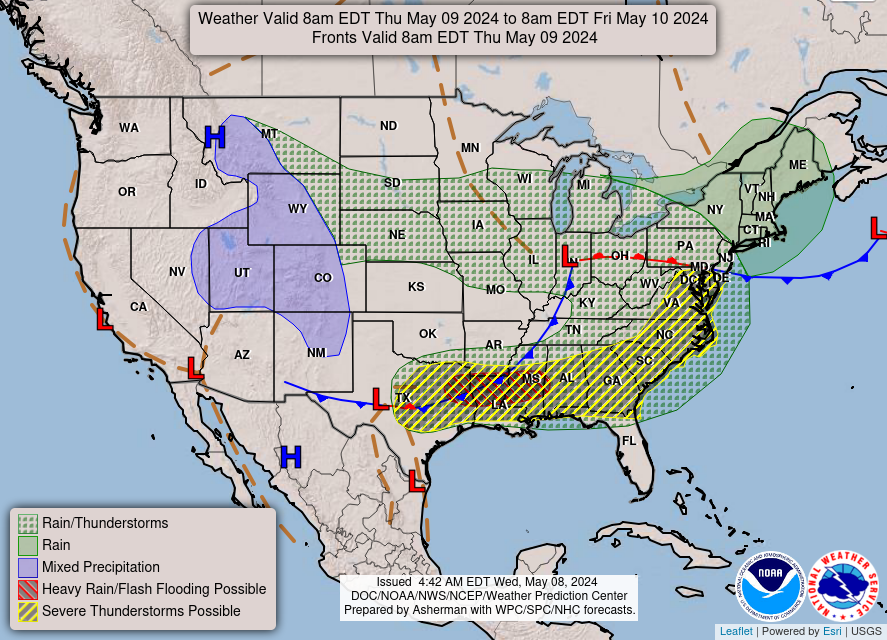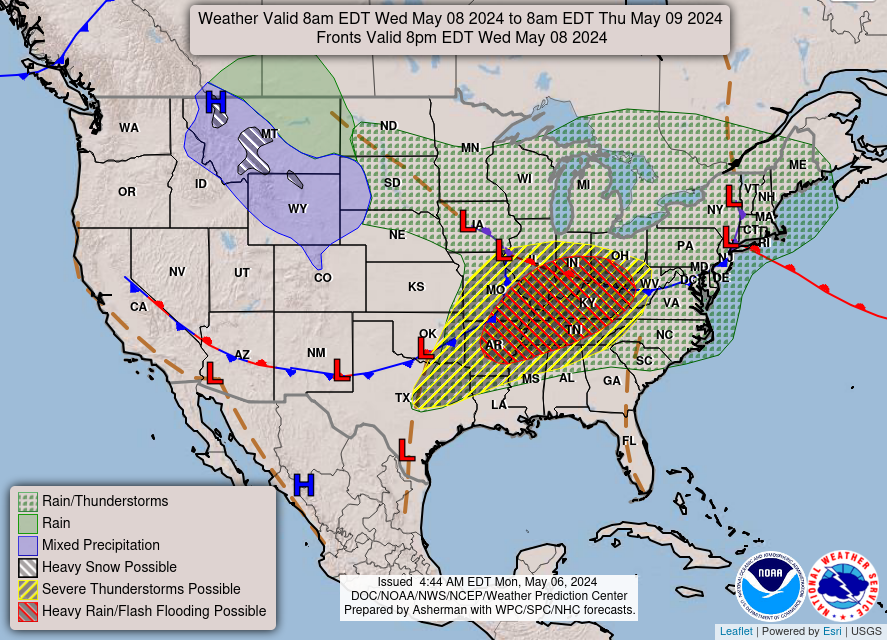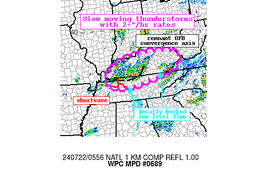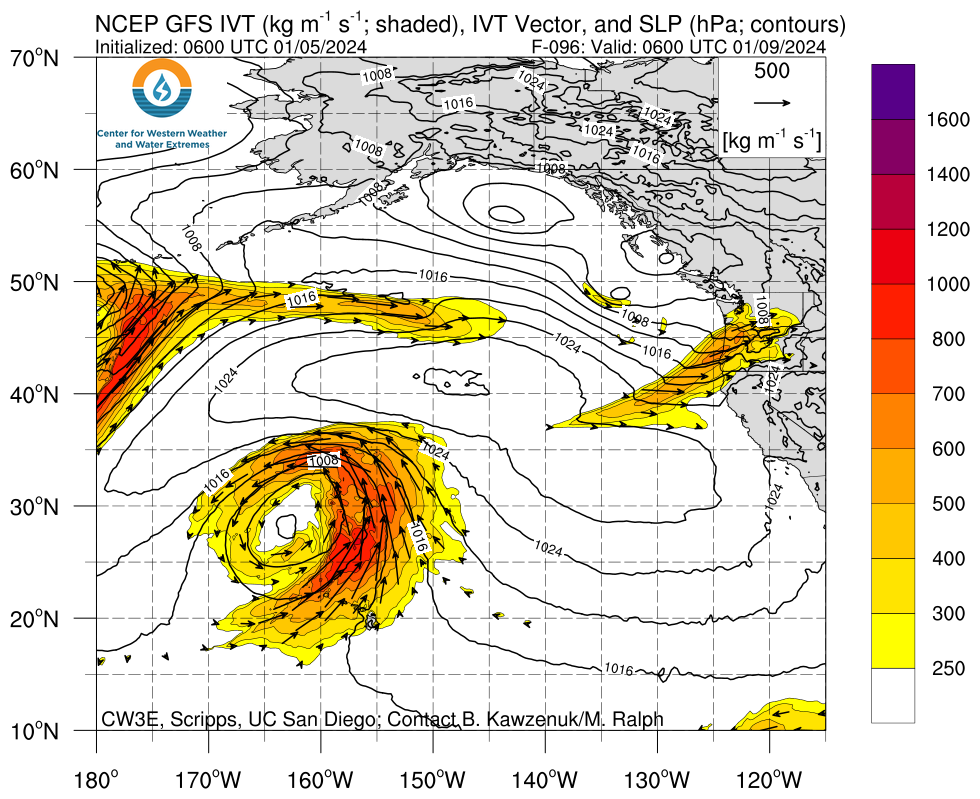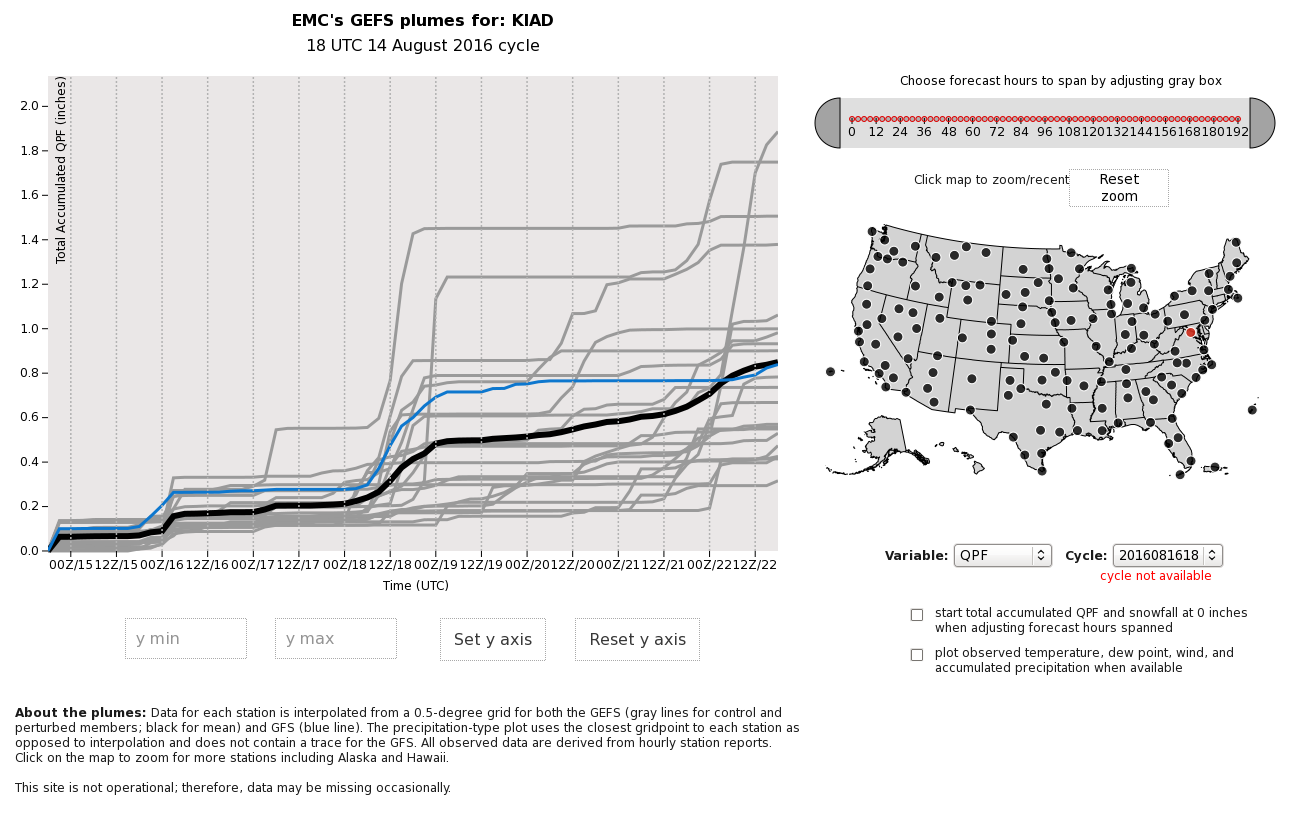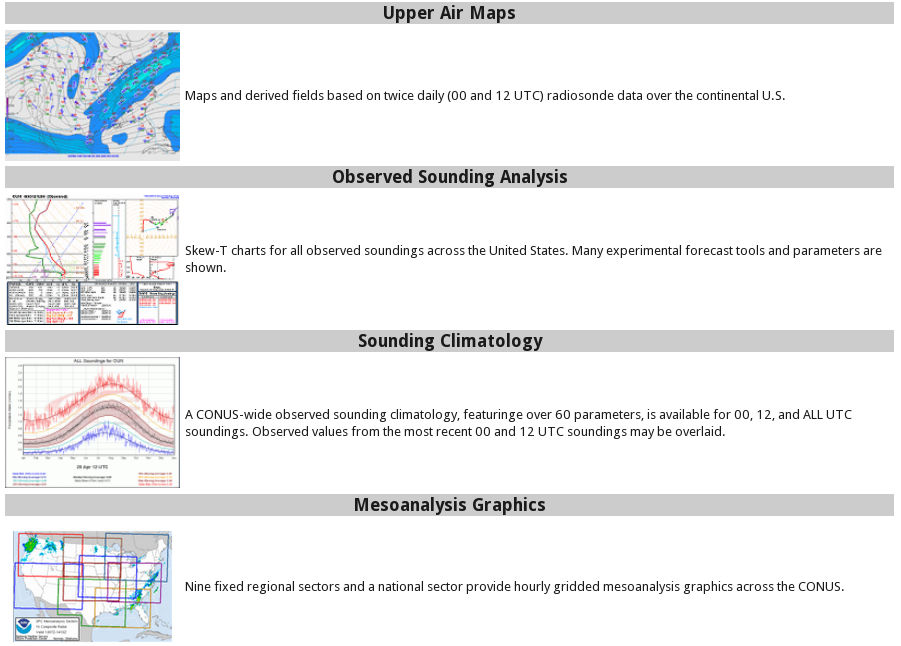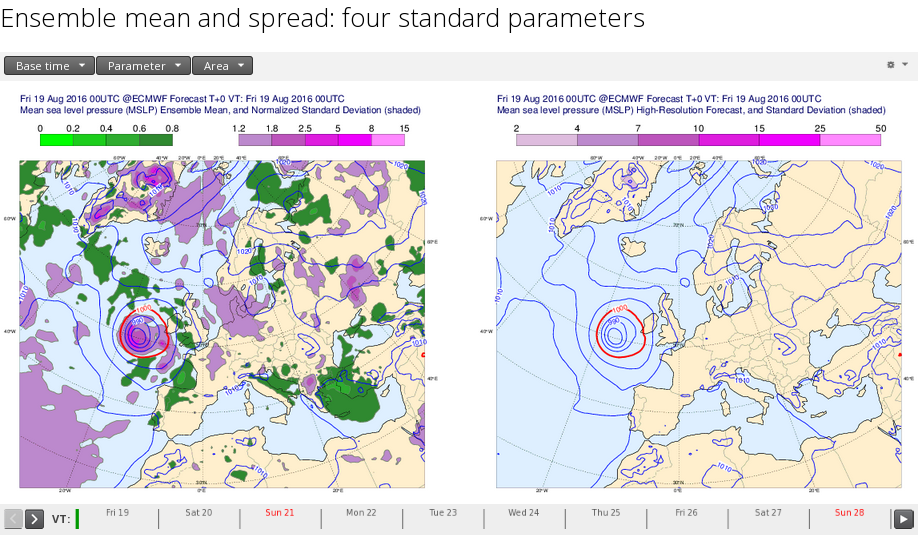Valid Mon Jul 22, 2024
Valid Tue Jul 23, 2024
Valid Wed Jul 24, 2024
+ Additional Links
- » Description of the National Forecast Chart
- » Product Archives
- » Download hazards in KML or shapefile format or GeoJSON format
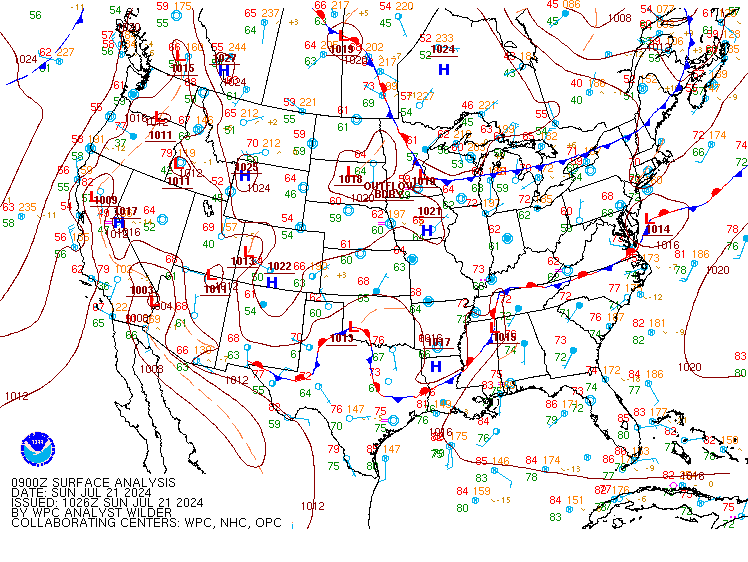
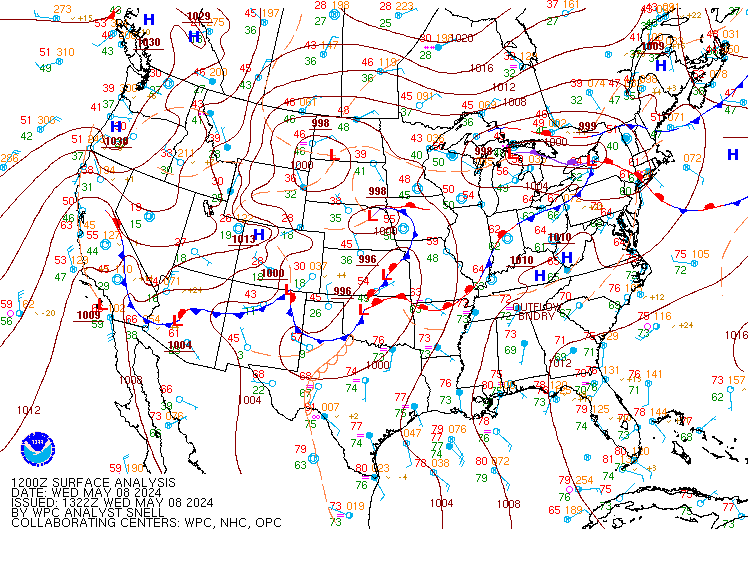
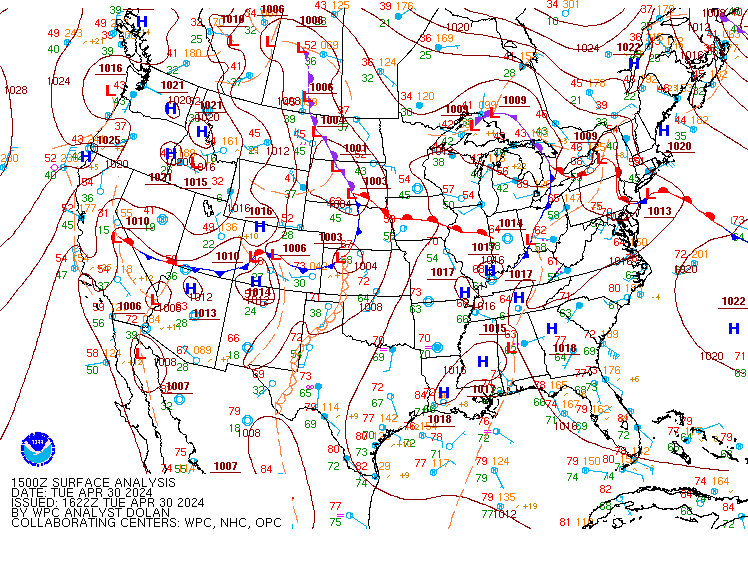
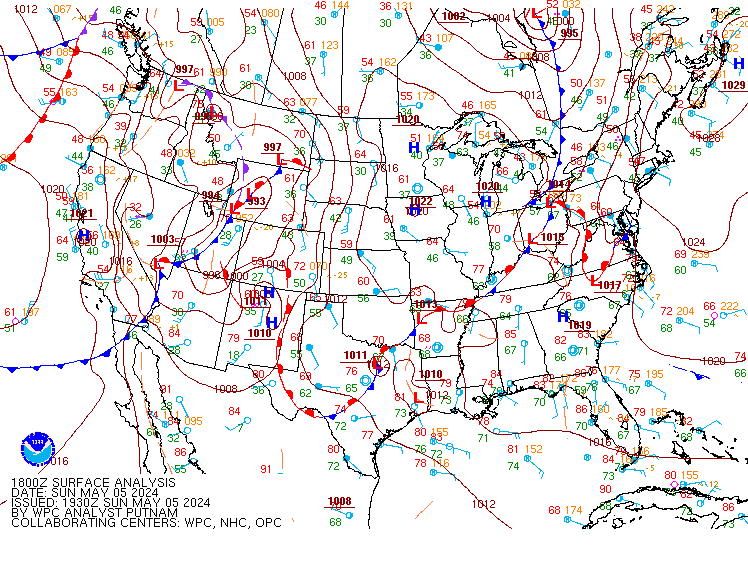
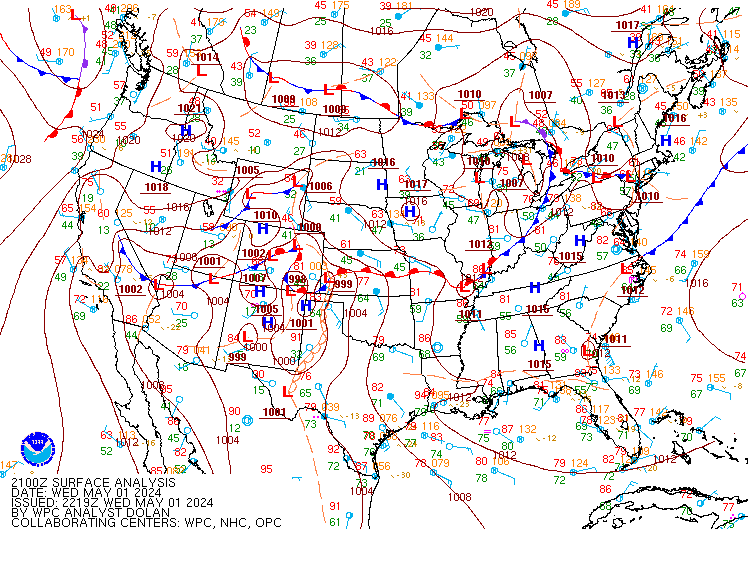
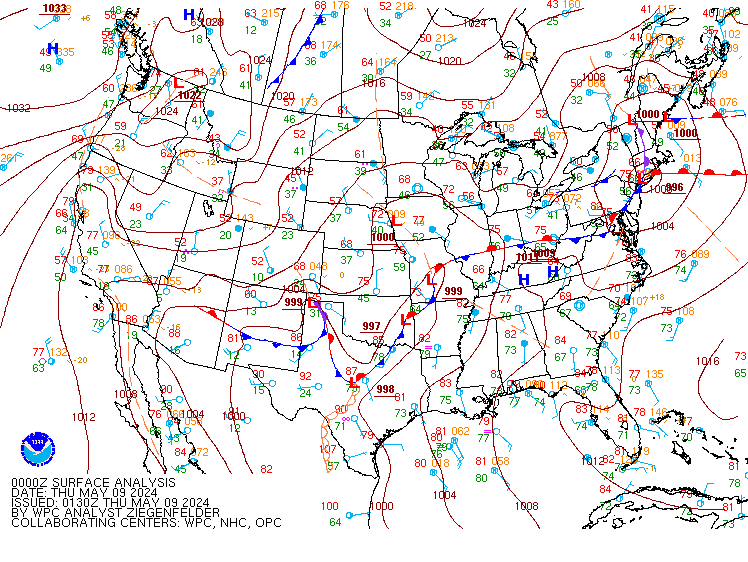
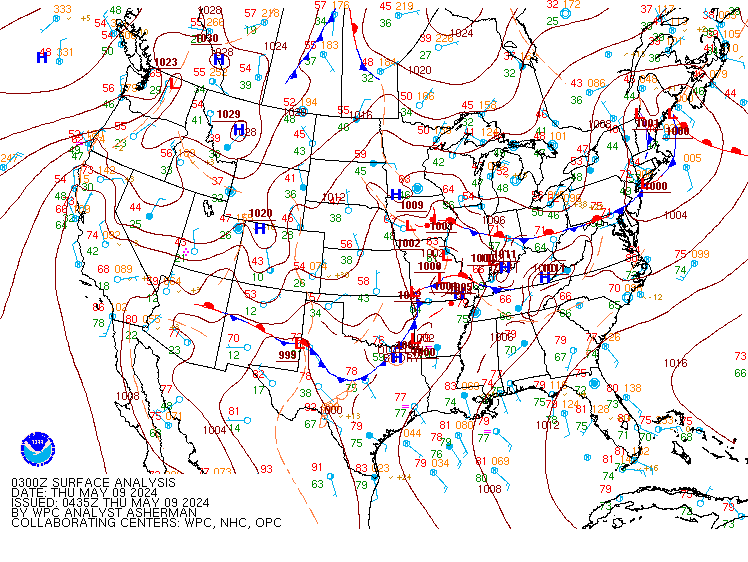
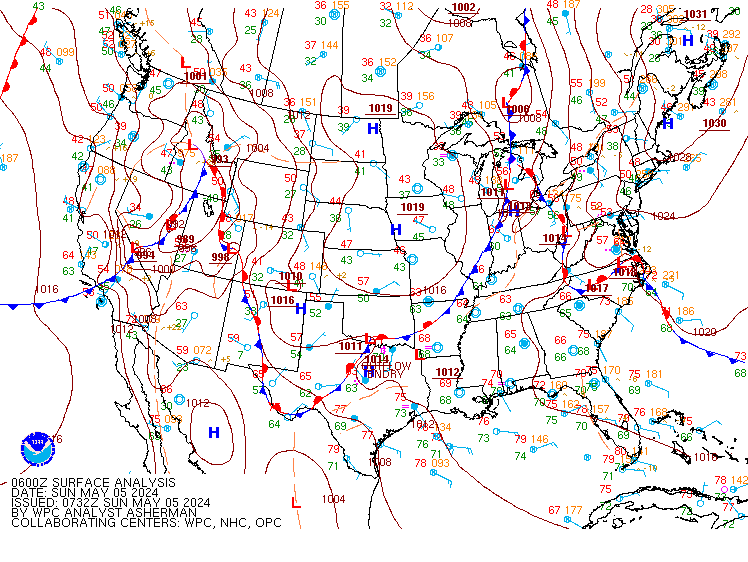
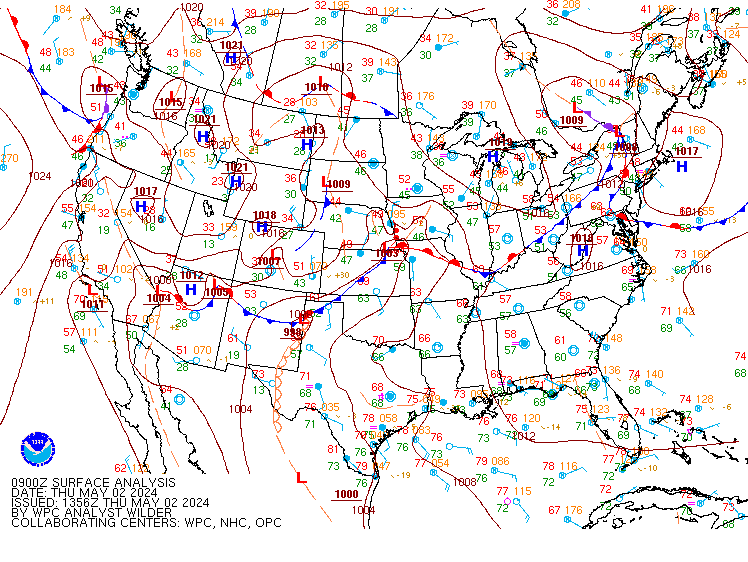
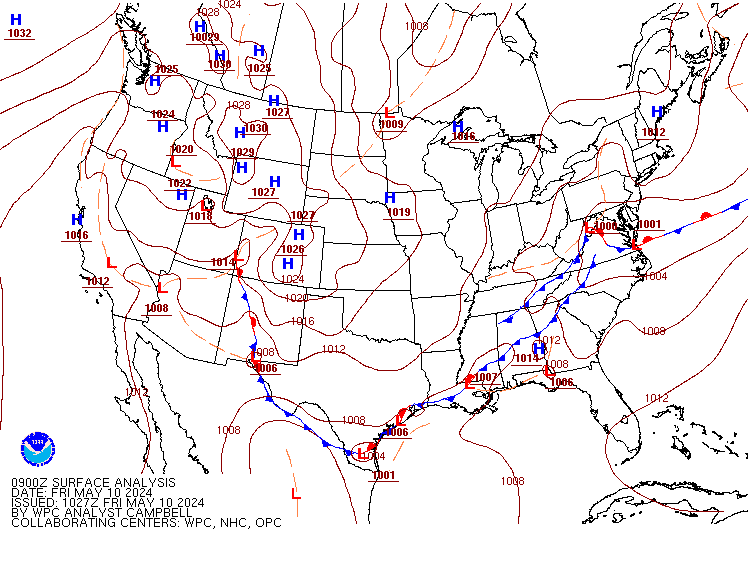
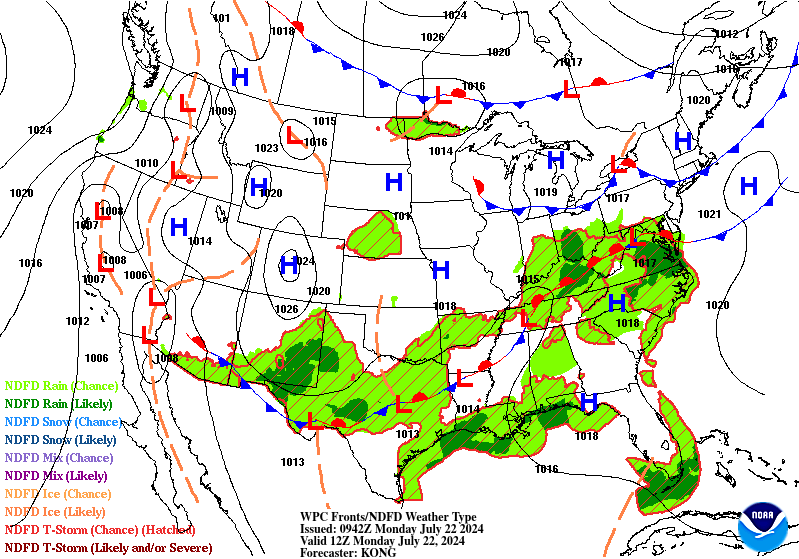
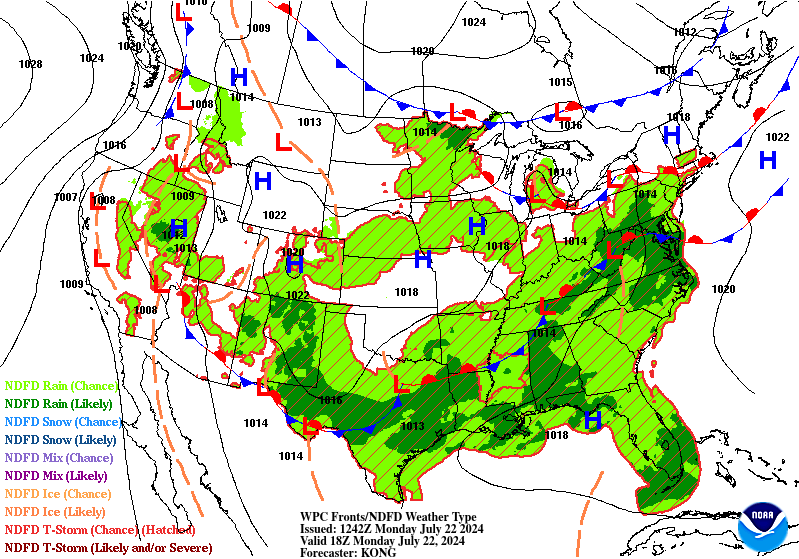
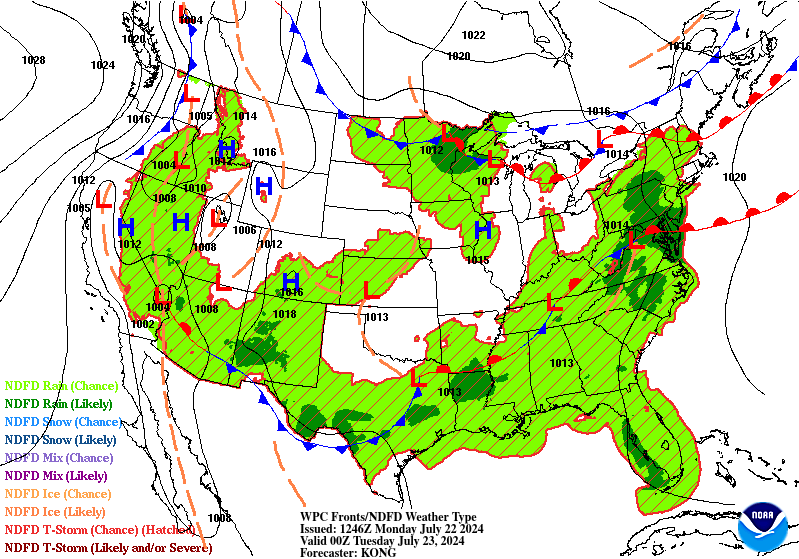
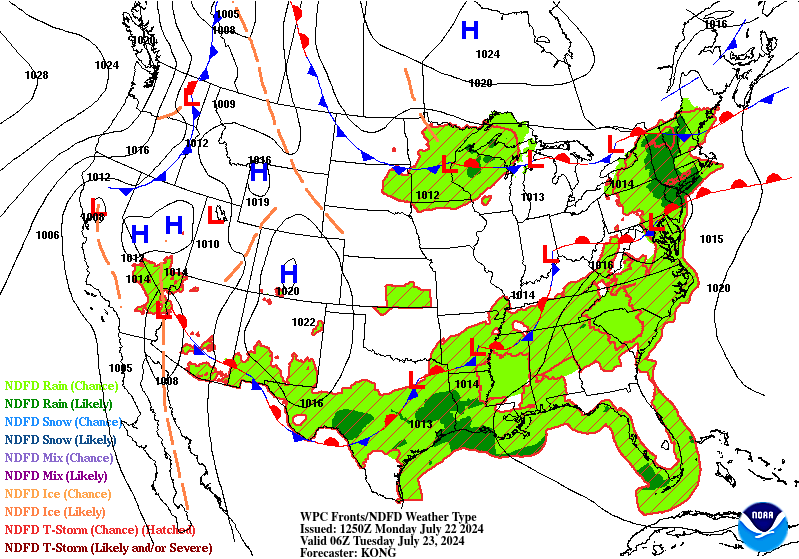
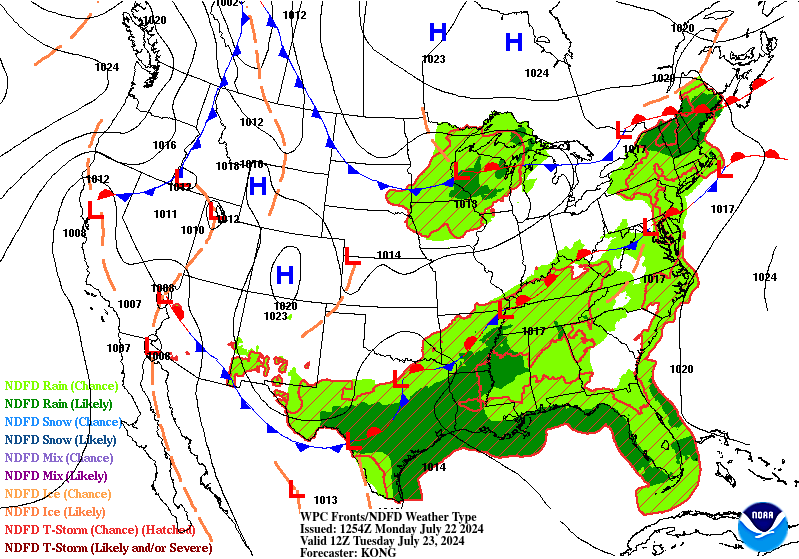
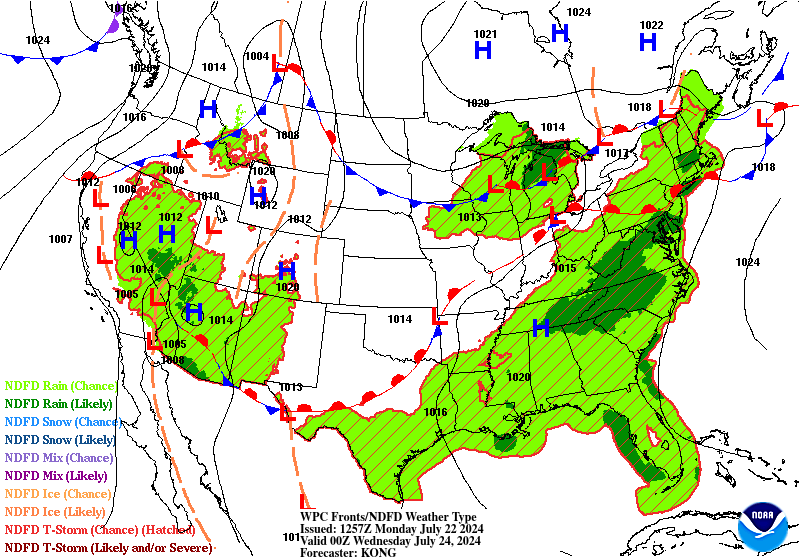
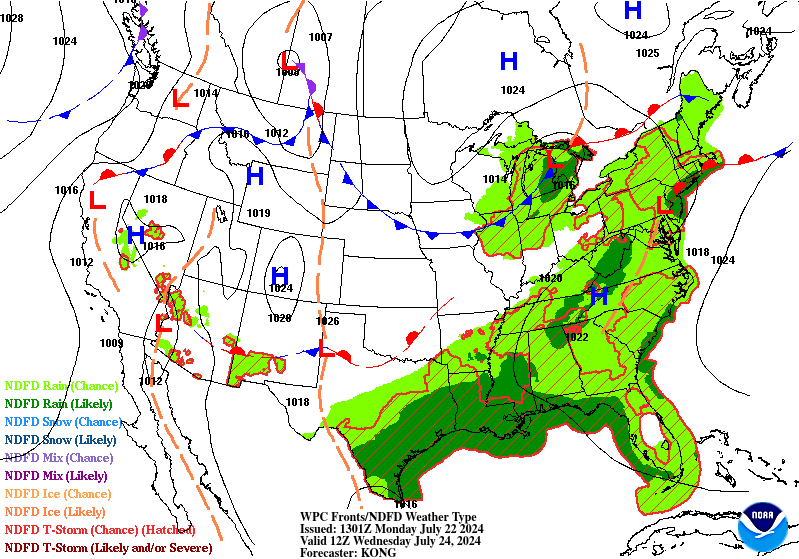
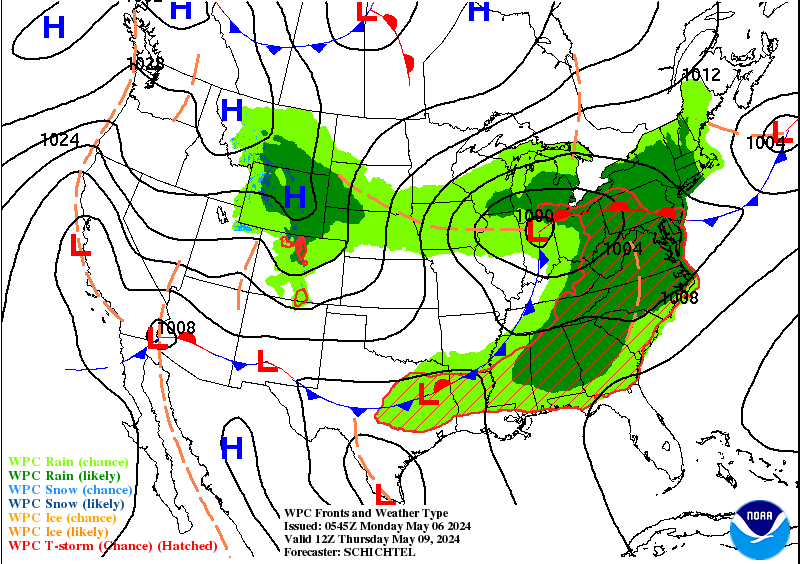
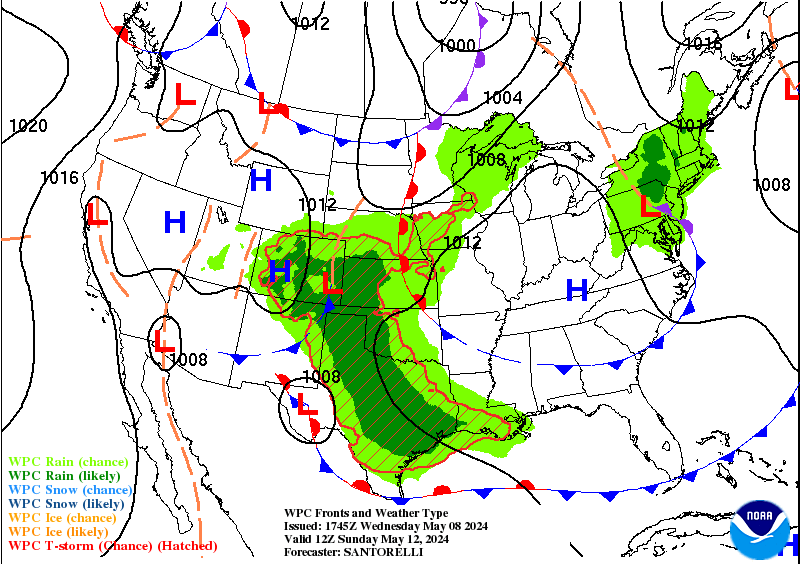
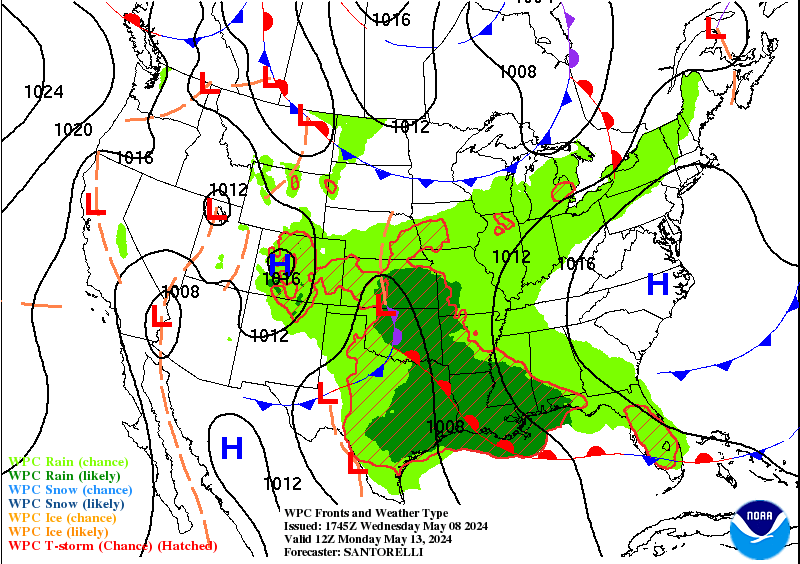

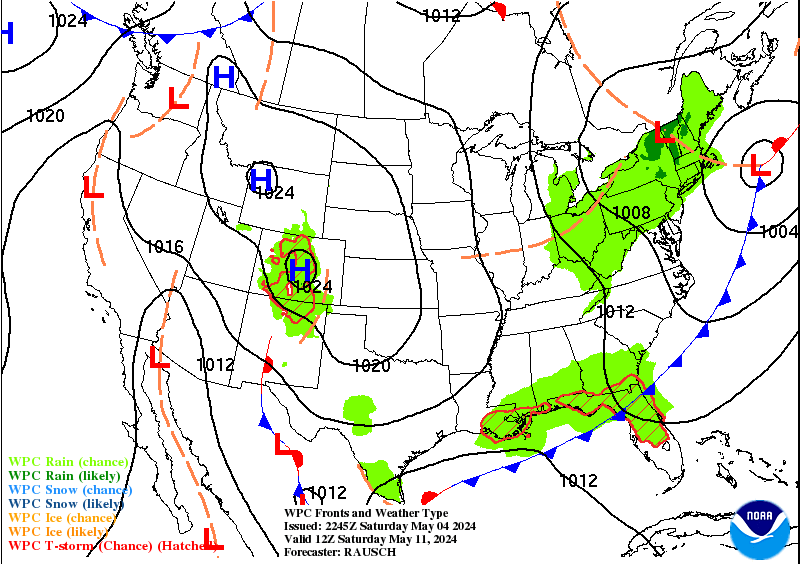
NWS Weather Prediction Center College Park MD
400 AM EDT Mon Jul 22 2024
Valid 12Z Mon Jul 22 2024 - 12Z Wed Jul 24 2024
...Major to locally extreme Heat Risk expected to expand from the Great
Basin into the northern High Plains by Wednesday as well as over portions
of the Central Valley of California...
....Scattered thunderstorms across the southern Plains to the Southeast
today near a stalled front will gradually shift toward the East Coast as
another front will spread additional thunderstorms across the Great Lakes
to New England Tuesday and Wednesday...
...Monsoonal thunderstorms continue across the Great Basin and into the
Four Corners region with threat of localized flash flooding...
A slow-to-evolve summertime weather pattern continues across the U.S.
mainland as we head into late July. This weather pattern will sustain the
ongoing heat wave across the western U.S. while maintaining cooler than
normal temperatures across the mid-section of the country and into
portions of the East Coast. The prolonged nature of the heat in the West
will keep the Heat Risk at major to locally extreme levels across portions
of the Central Valley of California, and the Great Basin today where
another afternoon of triple digit high temperatures is expected.
Meanwhile, a Pacific cold front will set things in motion a bit as the
front moves inland across the Pacific Northwest through the next couple of
days. Triple-digit high temperatures will then expand eastward into
northern High Plains by Wednesday ahead of the front while 110s will
persist across the Desert Southwest and 100s in the Central Valley of
California. Please continue to practice heat safety in this persistent
and prolonged heat wave in the western U.S.
In contrast, cooler than normal temperatures will prevail across the
mid-section of the country and into portions of the eastern U.S. where a
stalled front will keep plenty of clouds along with scattered
thunderstorms. These thunderstorms are not expected to be potent but they
could result in localized flooding issues from time to time across the
southern tier states. The upper-level pattern and instability that
support these thunderstorms from the southern Plains to the Southeast
today will gradually expand northeastward into the eastern U.S. on Tuesday
and then generally affect areas from across the Deep South into much of
the East Coast by Wednesday. Another cold front from eastern Canada will
dip into the northern tier states, bringing additional thunderstorms
across the Great Lakes to New England Tuesday and Wednesday. Meanwhile,
monsoonal thunderstorms will continue across the Great Basin and the Four
Corners region with the threat of localized flash flooding for the next
couple of days.
Kong
Graphics available at
https://www.wpc.ncep.noaa.gov/basicwx/basicwx_ndfd.php
...Overview and Guidance/Predictability Assessment...
Latest guidance agrees fairly well upon the idea of the large scale upper pattern featuring a mean trough along or a little inland from the West Coast. The most prominent system within this pattern should reach the West early-mid week with an atmospheric river containing some moisture of tropical origin, and then track across the Plains/east-central U.S. later in the week with an expanding area of precipitation over that part of the country. Another system dropping into the mean trough may reach the West Coast by next Friday.
The main focus forecast-wise during the period will be on the transition into a more energetic and amplified pattern over the CONUS as at least a couple upper-level waves enter the picture. An upper-level low over the Northeast will be departing over the Atlantic with energy lingering to the Southwest as a persistant upper-level low remains in place upstream over the Gulf of Alaska at the start of the period. A weak southern stream shortwave will be crossing the Southern Plains and moving into the Southeast, with the 00Z CMC still a bit ahead of the other guidance, similar to previous runs. The prior few runs of the GFS continue to show this wave deepening near the Atlantic Coast, and this is even hinted at in recent runs of the ECMWF. However, the 00Z and particularly the 06Z GFS runs have once again backed off this trend. On the other hand, the guidance has come into better agreement with an initial batch of energy ejecting from the low over the Gulf of Alaska as a compact shortwave over the Pacific Northwest early in the forecast period. Attention then turns to the Gulf of Alaska low dropping southward and moving over the West by mid-period, sweeping up a surge of moisture over the Pacific to instigate another Atmospheric River even for California in the process. The guidance is in fairly good agreement on the evolution of this pattern on a larger-scale, but potentially significant disagreements pop up in the handling of embedded energy, specifically a shortwave/compact upper low translating northward over the central U.S. that has implifcations for surface cyclo/frontogenesis over the Plains. The 00Z CMC is a bit more agressive overall in depiciting a much stronger deepening low as opposed to a weaker low/open wave in recent runs of the ECMWF and GFS. The GFS and ECMWF also show a bit more amplified ridge downstream ahead of the troughing over the West. Details become even more cumbersome by the end of the period as another trough begins to dig in the West. This general pattern is captured in the lateast 00Z/06Z GFS and 00Z ECMWF runs as well as the 00Z GEFS and ECens means, while the 00Z CMC is less agressive and only hints at a weaker shortwave over the Southwest. More specific details in the evolution of split-stream energy downstream over the East is not consistent either run-to-run within the individual guidance or in comparison between different models. Even the 00Z GEFS/ECens means show potentially significant differences with the GEFS mean stronger with both features late in the period.
The WPC forecast blend begins with contributions from the 06Z GFS and 00Z ECMWF/UKMET and a smaller influence from the 00Z CMC given differences with respect to the southern stream shortwave. Contributions from the 00Z GEFS/ECens means are added as the influence of the 00Z CMC is removed in the middle of the period as this solution diverges more significantly in the handling of the evolution of the pattern over the central U.S. mid-late period compared to the other guidance. The 00Z GEFS/ECens means are relied on more heavily towards the end of the period given the rapidly increasing uncertainty with respect to smaller-scale shortwaves in the flow. The means help to capture the broader pattern between the initial troughmoving from the central to eastern U.S. and the next trough digging in the West.
...Weather/Hazards Highlights...
A fairly weak leading system will support areas of rain and higher elevation snow that should be in progress across a decent portion of the West at the start of the period on Monday. Then a stronger upper trough digging toward the West Coast, along with associated low pressure/frontal system, will direct a plume of enhanced moisture into parts of California and southwestern U.S. around Tuesday. Expect a period of moderate to heavy lower elevation/coastal rain and heavy high elevation snow especially in the Sierra Nevada. Rainfall totals should be less extreme than this past week's events while snow levels remain lower, somewhat reducing the flooding/runoff risk in comparison. However, the forecast rainfall totals along with existing wet ground conditions do appear to support a Marginal Risk in the day 5 (12Z Tuesday-12Z Wednesday) Excessive Rainfall Outlook for areas from the lower elevations of the Sierra Nevada to the southern California coastal ranges, as well as favored terrain over central Arizona. Eastward progression of this system should then bring significant snowfall into parts of the Great Basin and central Rockies Tuesday-Wednesday. This system should then emerge over the Plains and Great Lakes by Thursday-Friday, with some snow possible over far northern areas and rain/thunderstorms over the eastern Plains/east-central U.S. Currently expect the heaviest rainfall to extend from the ArkLaTex region into the Lower Ohio Valley. Another Pacific system may bring rain and mountain snow to the Pacific Northwest and parts of California toward the end of the week.
The early part of the week will see well below normal temperatures across the southern tier with some localized readings of 20F or so below normal. Near or below freezing lows over some areas may be harmful to any new spring vegetation. There will be a steady warming trend over the eastern half of the country to above normal temperatures by the latter half of the week, ahead of the system tracking out of the West. The mean trough aloft over the West will maintain a broad area of below normal highs across that region, with minus 10-20F anomalies most common Tuesday onward. The far northern Plains will also see below normal temperatures for most of next week, especially on Monday-Tuesday.
Putnam/Rausch
Additional 3-7 Day Hazard information can be found on the WPC medium range hazards outlook chart at: https://www.wpc.ncep.noaa.gov/threats/threats.php
WPC medium range 500mb heights, surface systems, weather grids, quantitative precipitation, experimental excessive rainfall outlook, winter weather outlook probabilities and heat indices are at:
https://www.wpc.ncep.noaa.gov/medr/5dayfcst500_wbg.gif
https://www.wpc.ncep.noaa.gov/medr/5dayfcst_wbg_conus.gif
https://www.wpc.ncep.noaa.gov/5km_grids/5km_gridsbody.html
https://www.wpc.ncep.noaa.gov/qpf/day4-7.shtml
https://www.wpc.ncep.noaa.gov/#page=ero
https://www.wpc.ncep.noaa.gov/wwd/pwpf_d47/pwpf_medr.php?day=4
https://www.wpc.ncep.noaa.gov/heat_index.shtml
$$
Hawaii Extended Forecast Discussion
NWS Weather Prediction Center College Park MD
350 AM EDT Mon Jul 22 2024
Valid 00Z Tue Jul 23 2024 - 00Z Tue Jul 30 2024
High pressure initially to the north-northeast of the state near
40N latitude and slowly retrograding thereafter will support
trades and generally windward-focused showers during the period.
Guidance consensus still suggests that the strongest winds should
be in the mid-late week time frame, with a developing weakness
aloft to the north/west of the main islands helping to loosen the
surface pressure gradient somewhat during the weekend. Meanwhile
the models and ensembles have maintained continuity with an area
of enhanced moisture (likely in two distinct pockets) crossing the
area around Tuesday-Wednesday. This moisture may increase
rainfall totals somewhat. Most solutions have trended toward
somewhat slower departure of the moisture on Thursday, but
continue to show a period of below-climatology precipitable water
values (with corresponding lighter rainfall) from Friday through
the weekend. There is a little more spread for moisture by next
Monday with no clear clustering at this time.
Rausch
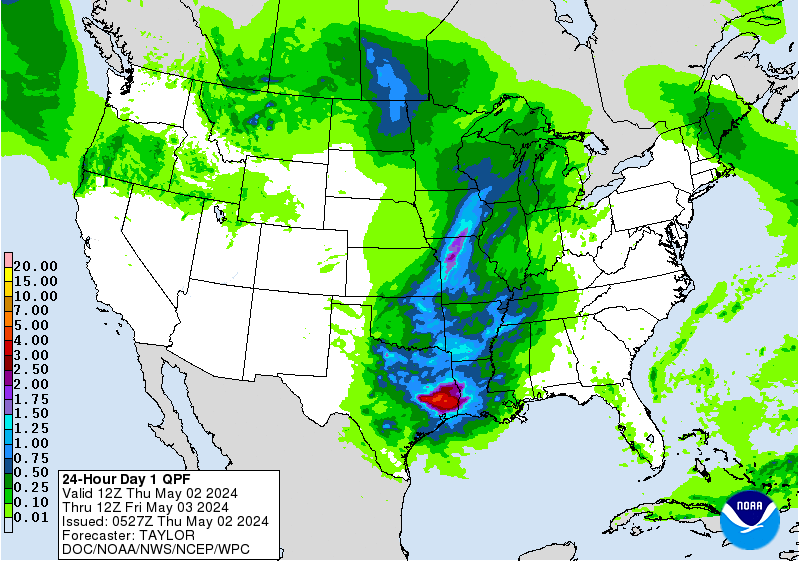
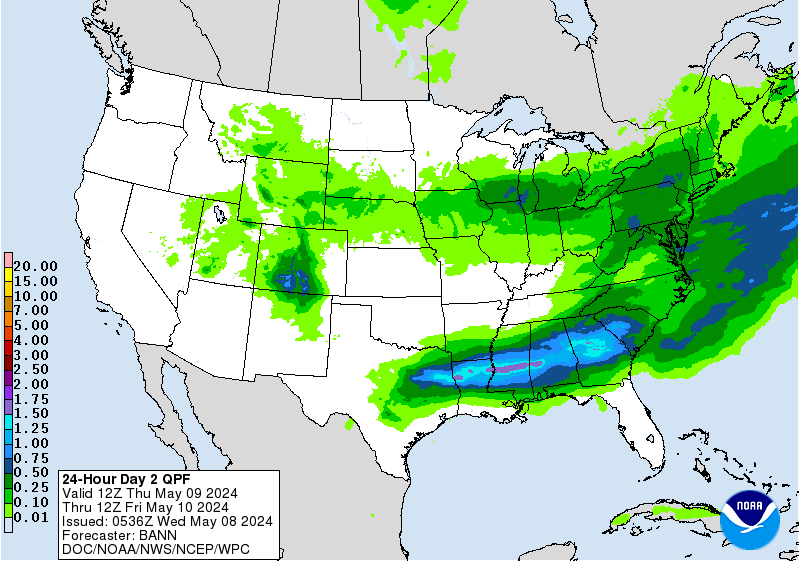
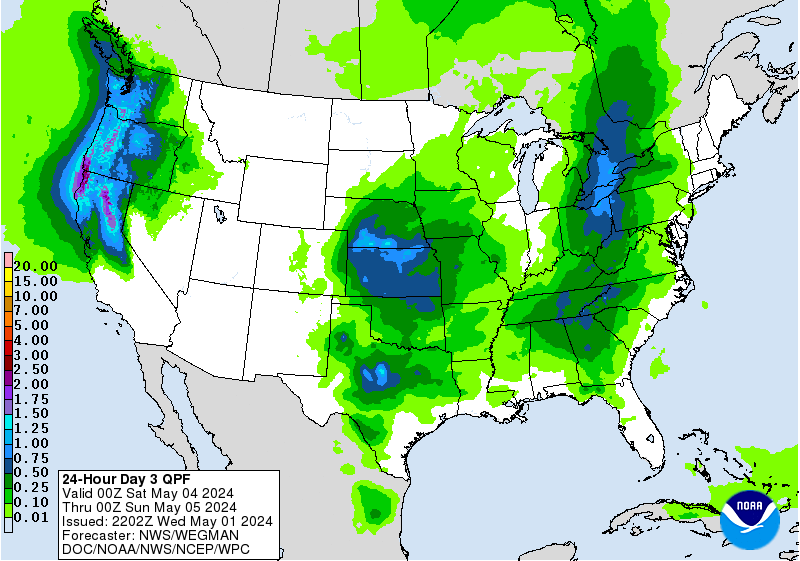
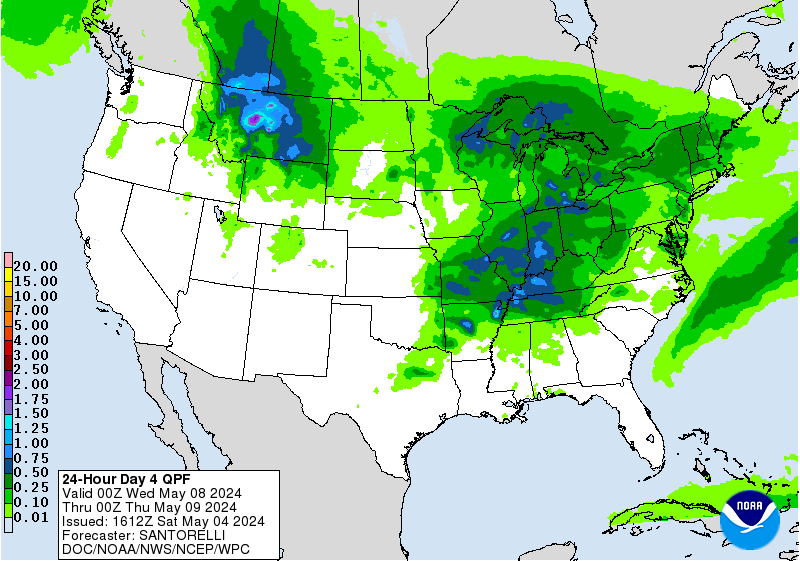
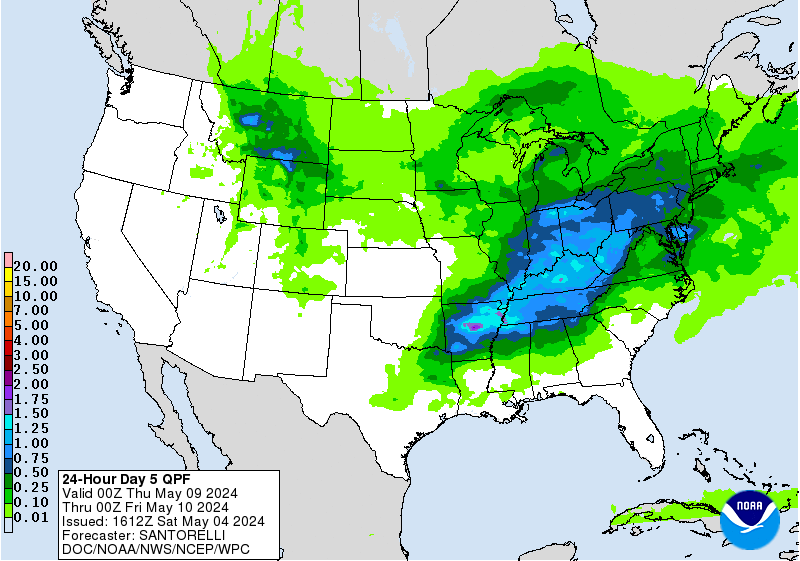
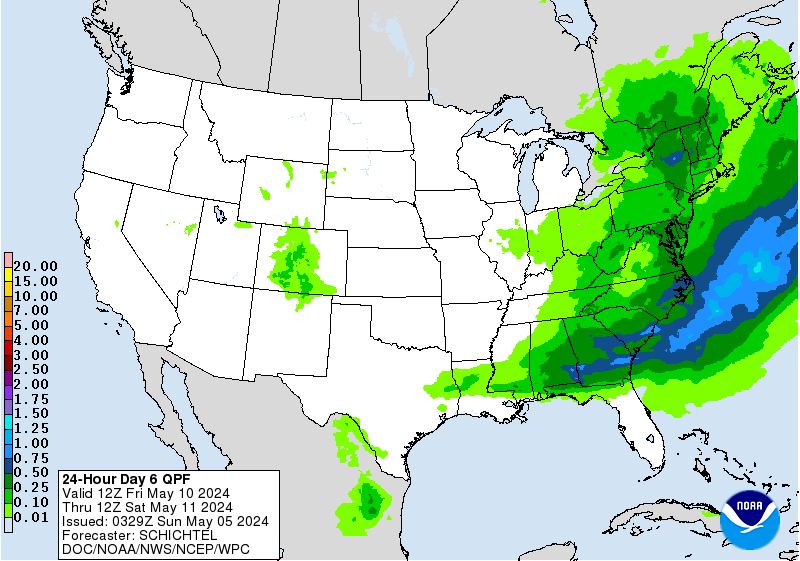
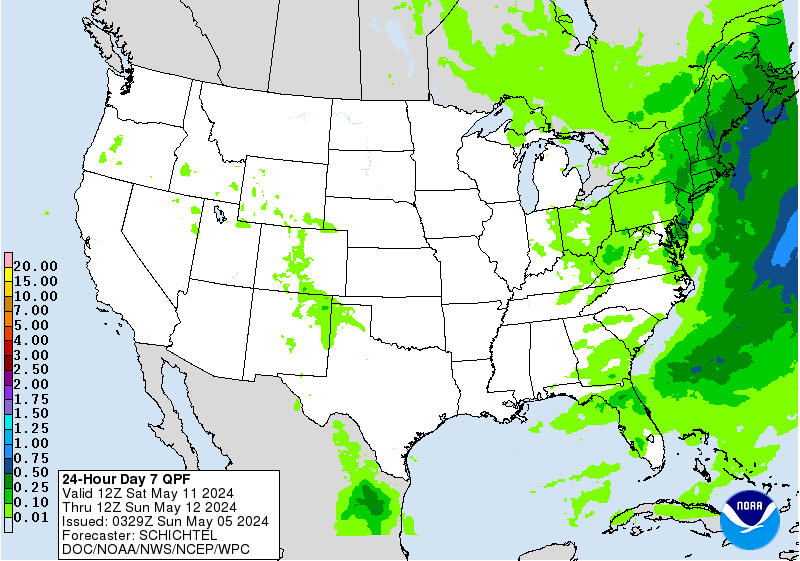
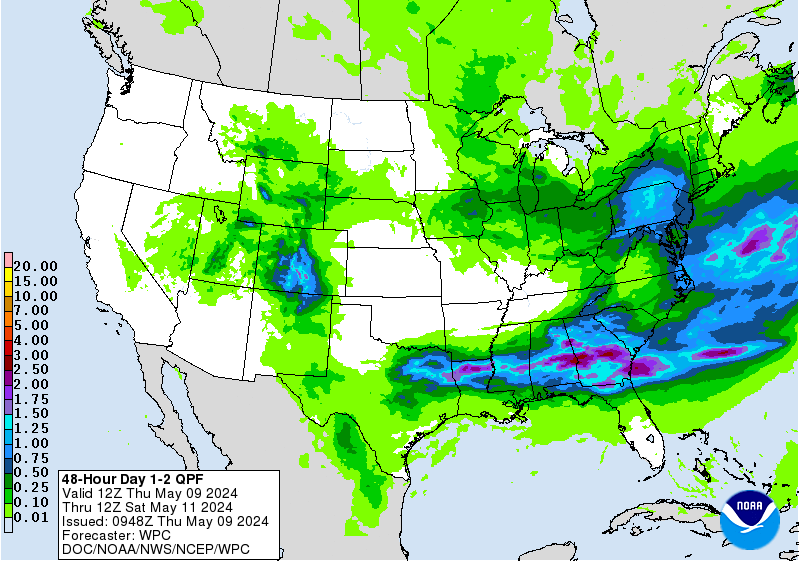
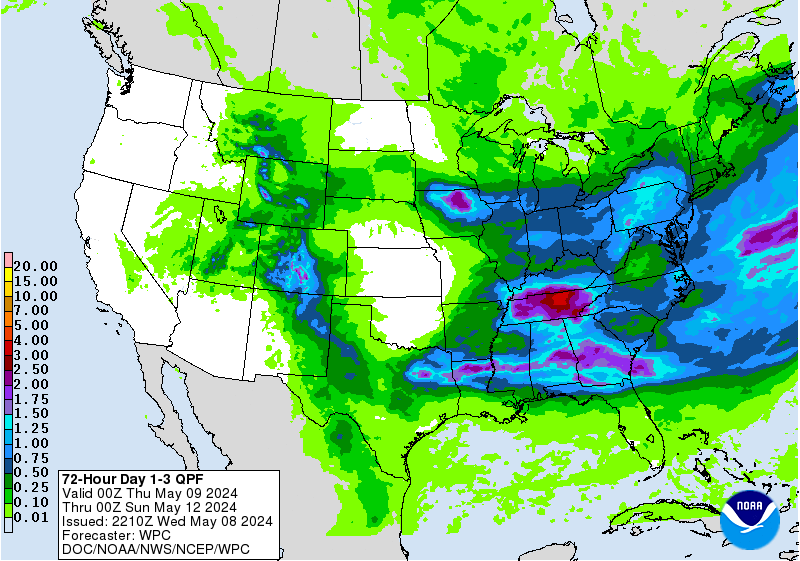
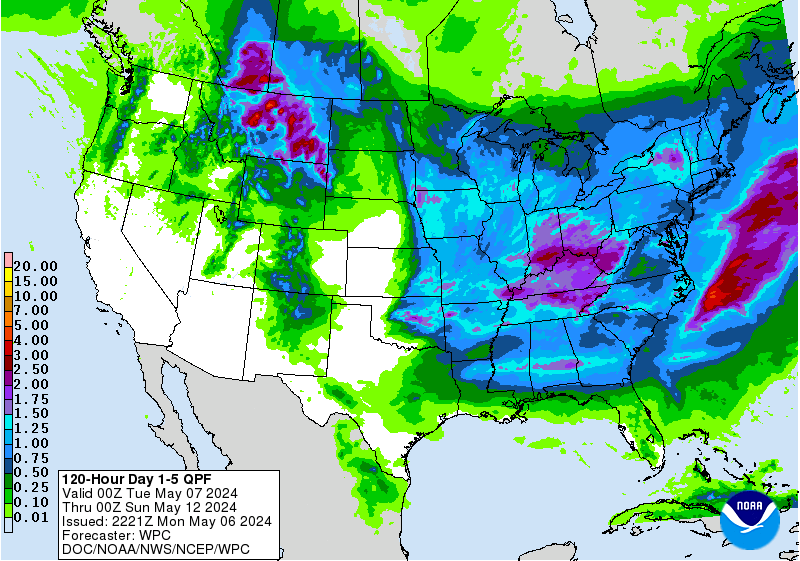
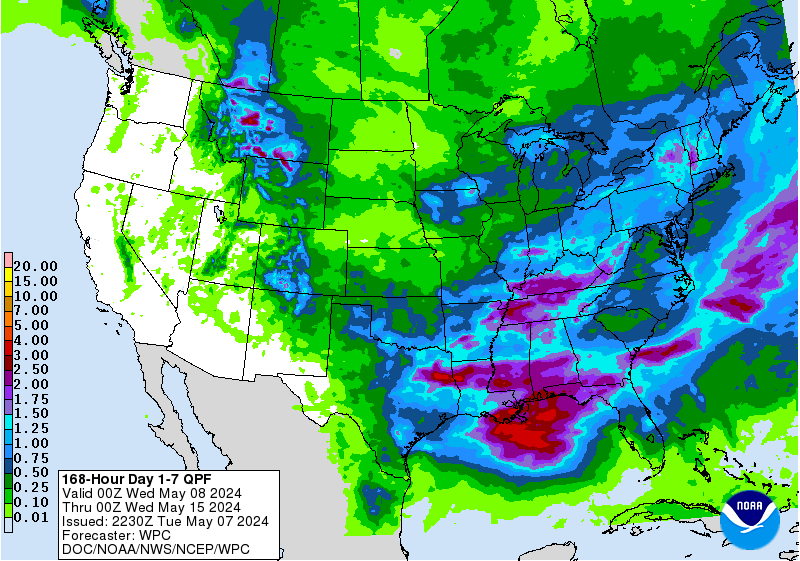

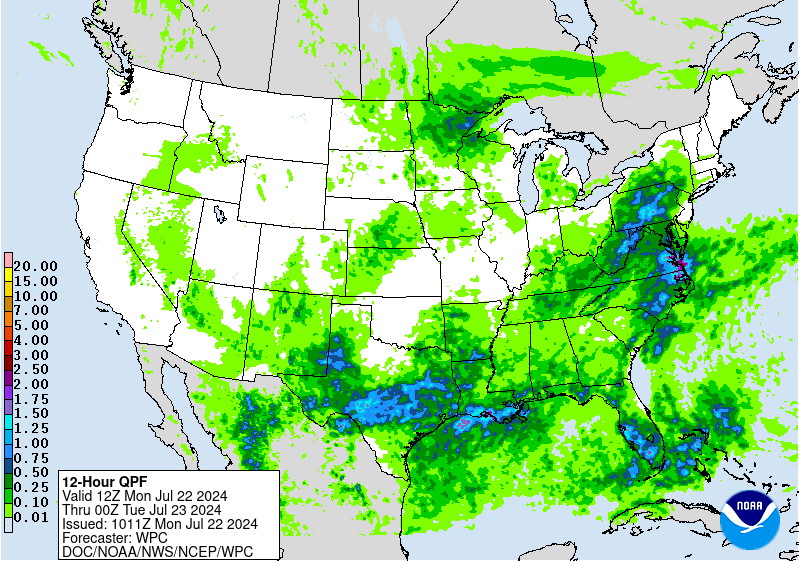
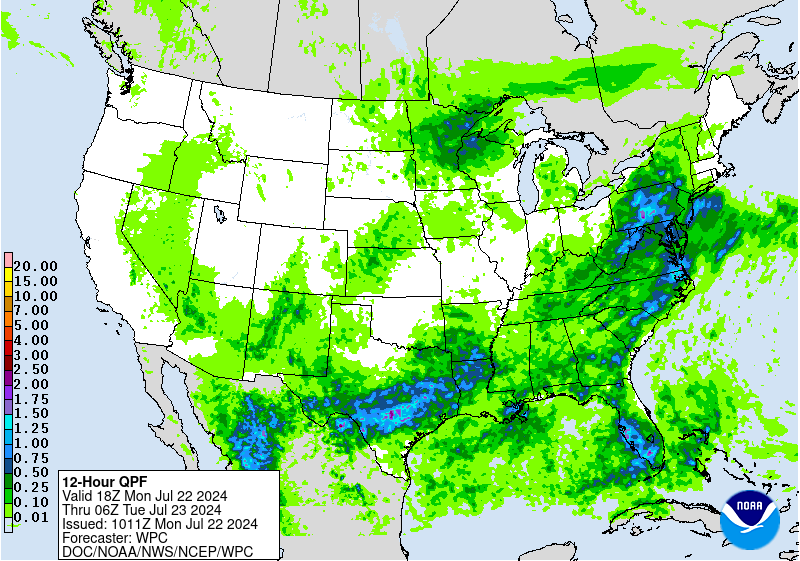
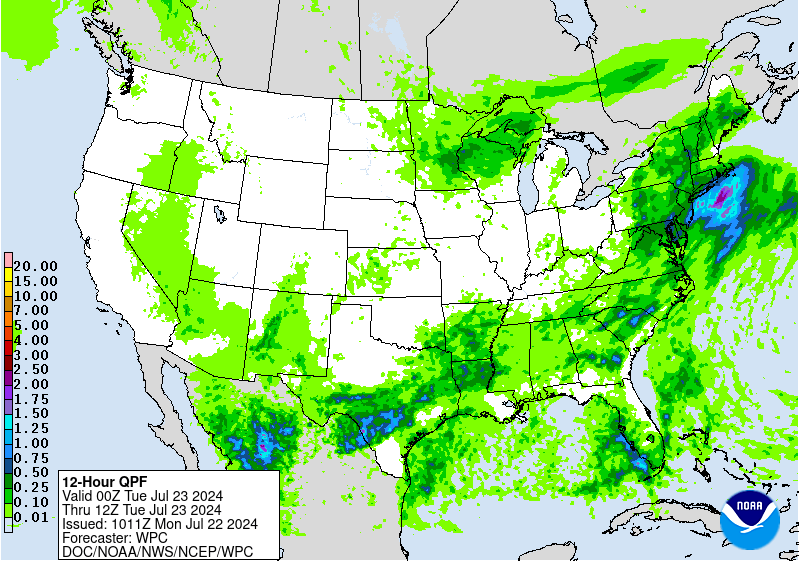

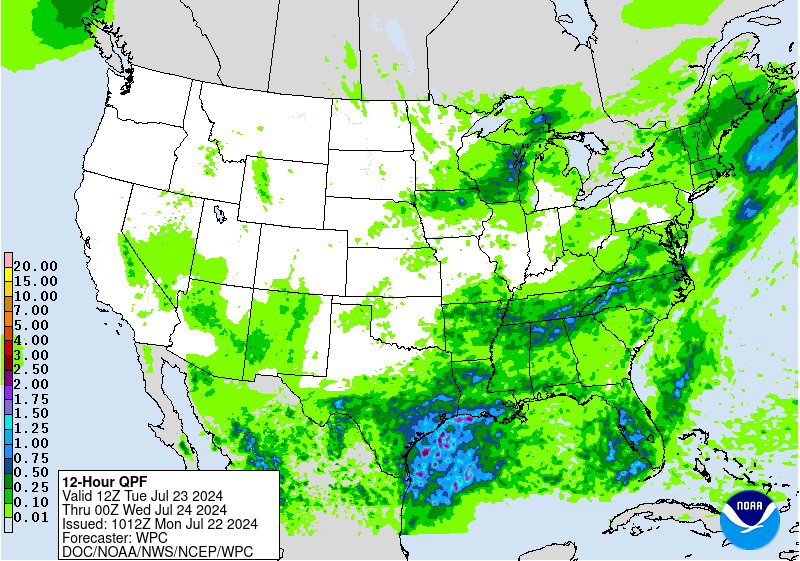
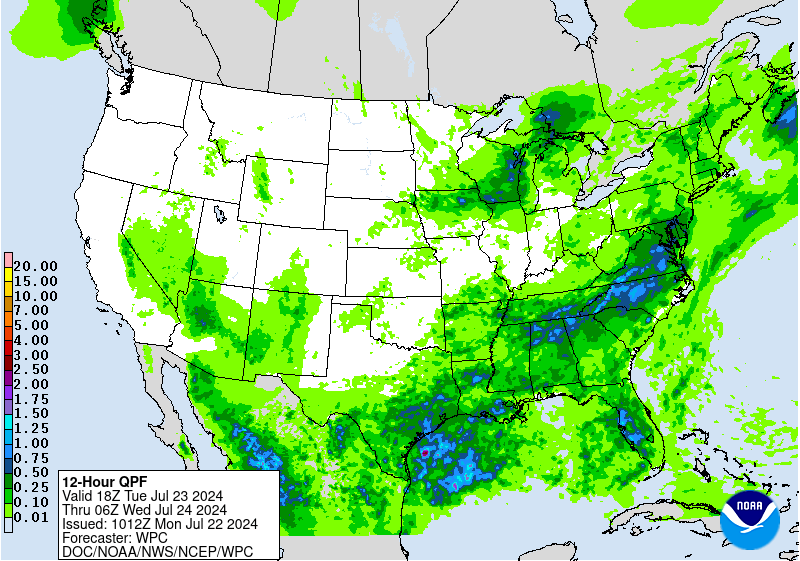
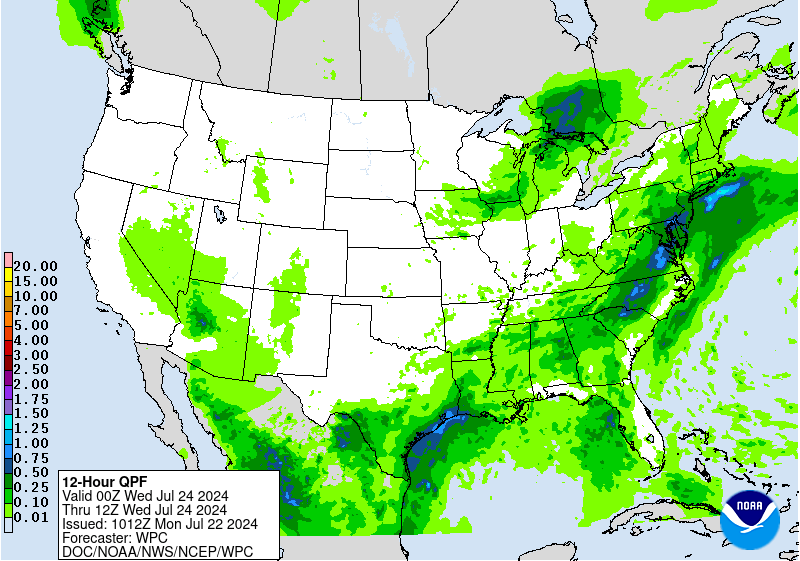
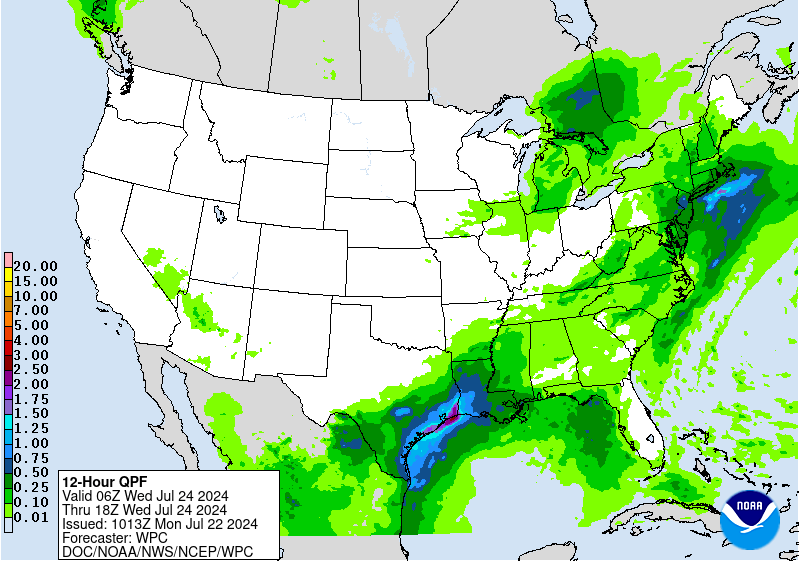
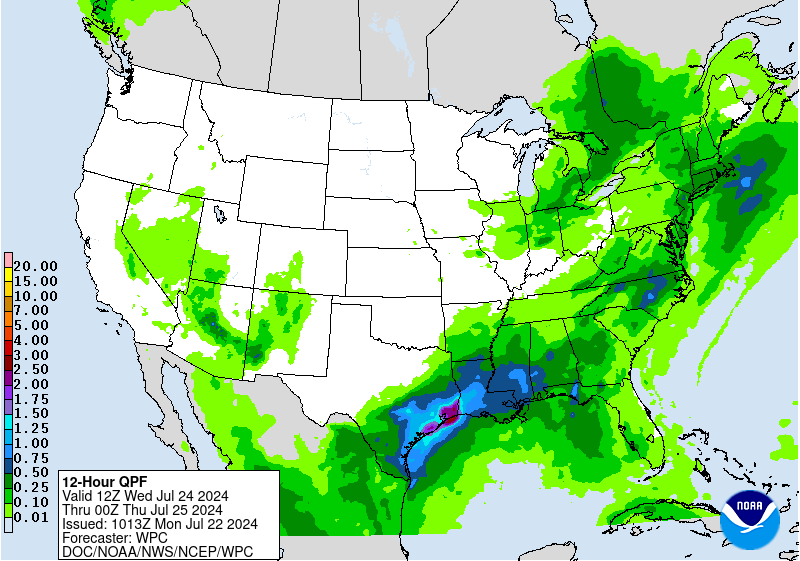
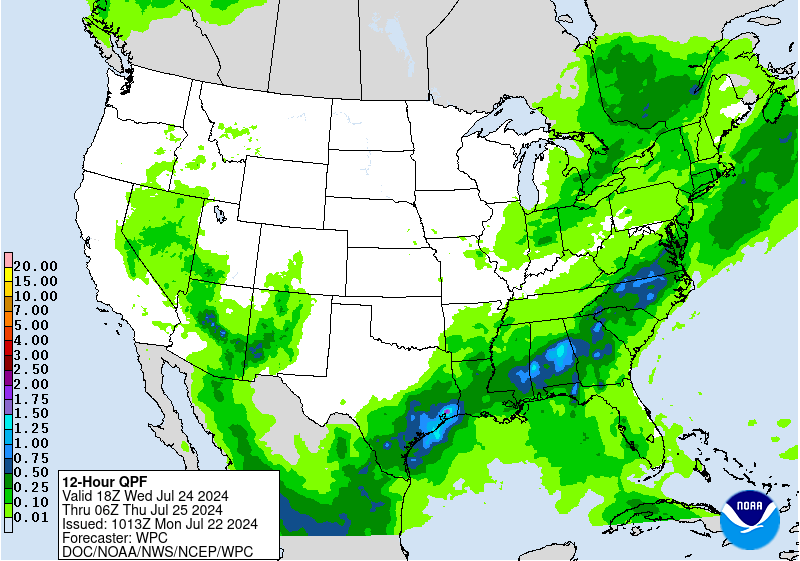
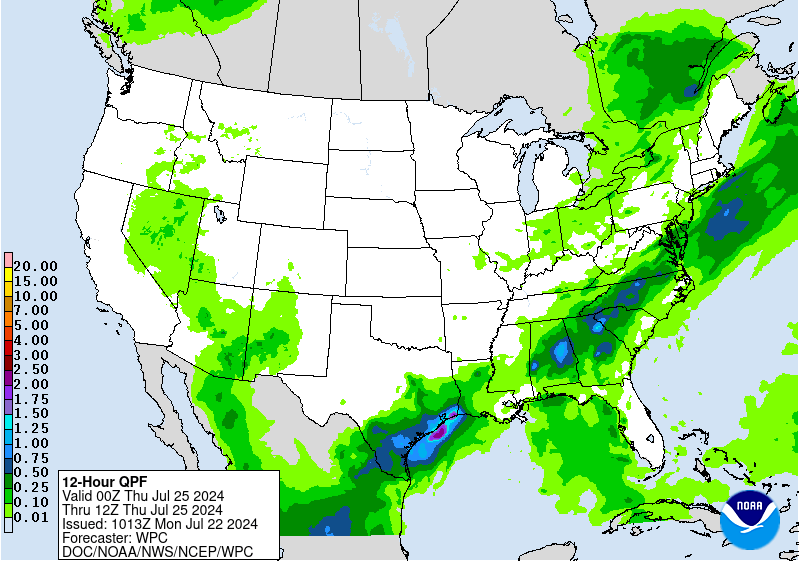

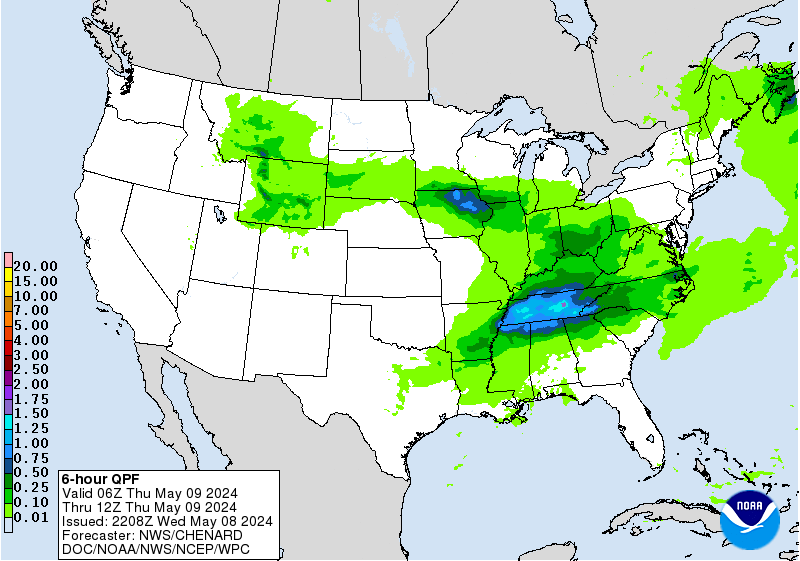
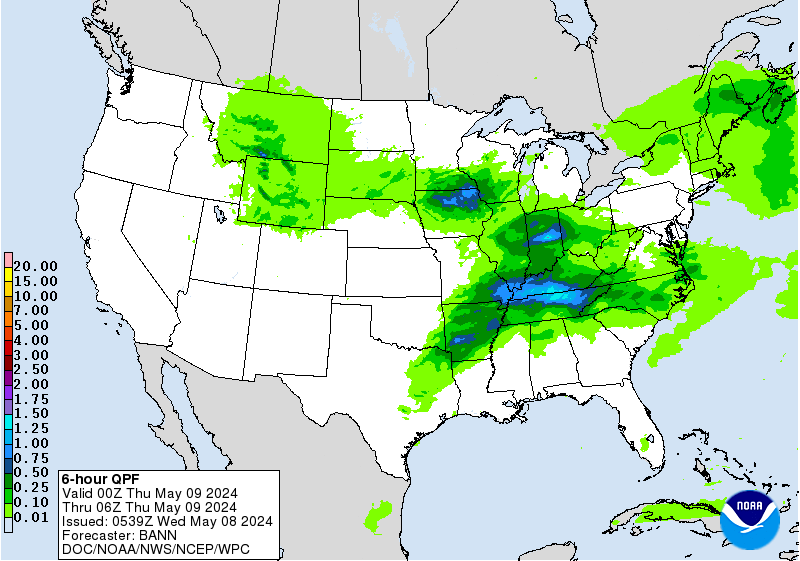

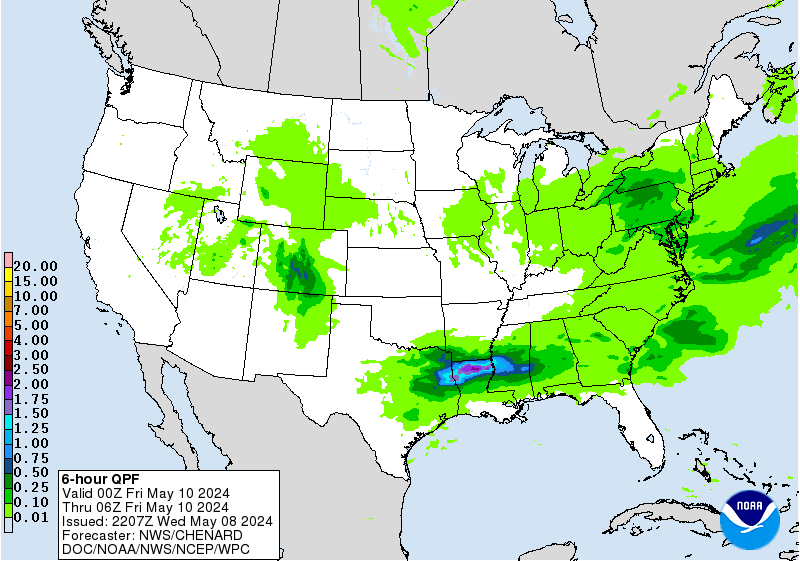
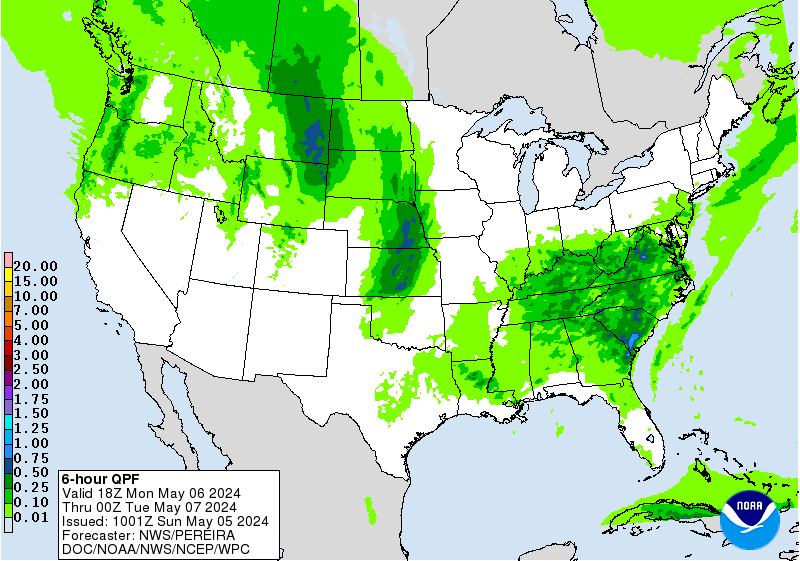
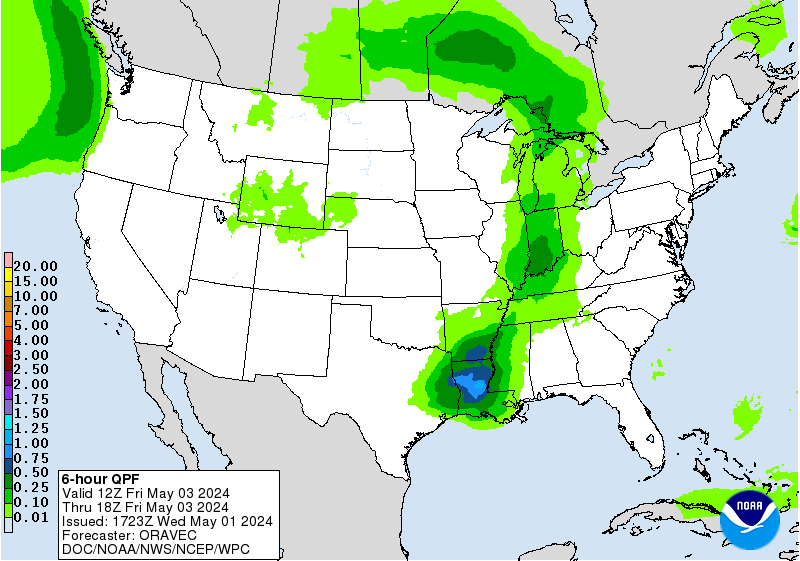
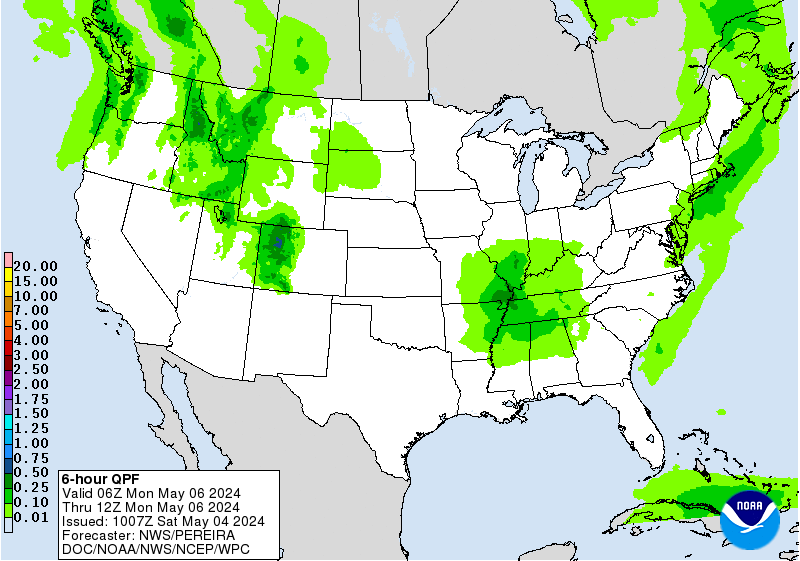
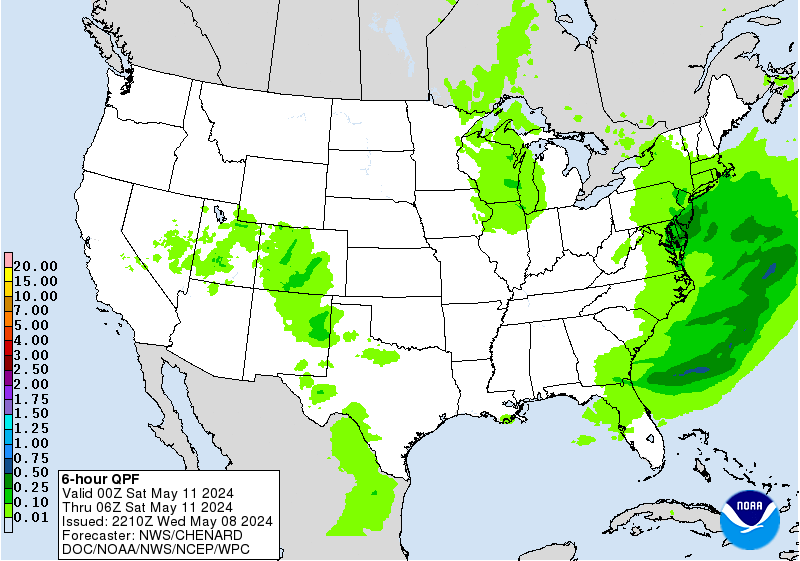
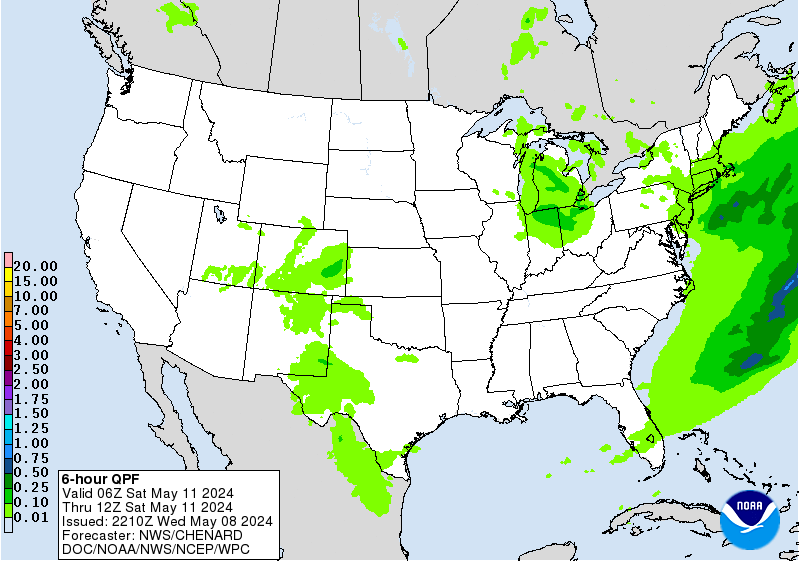
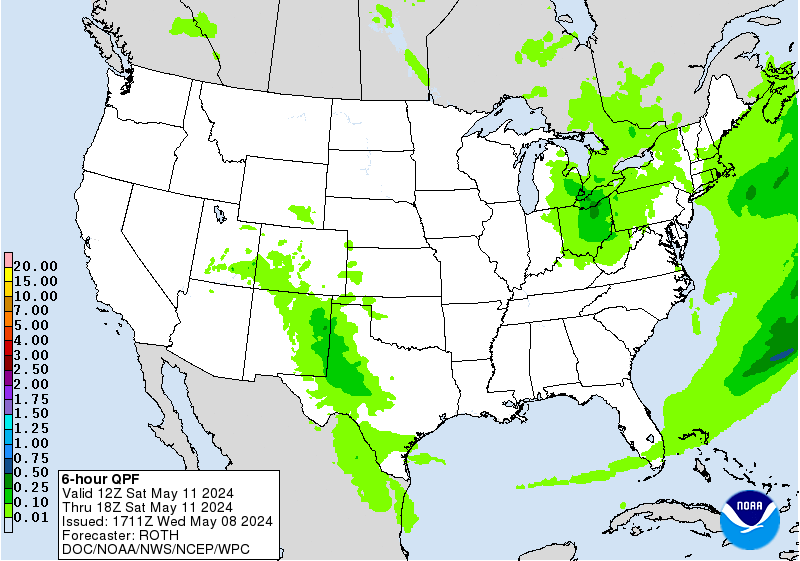

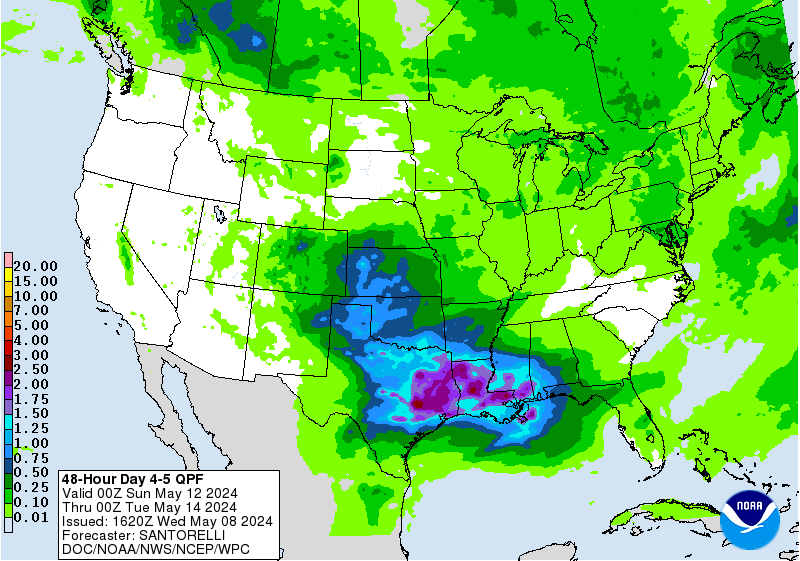
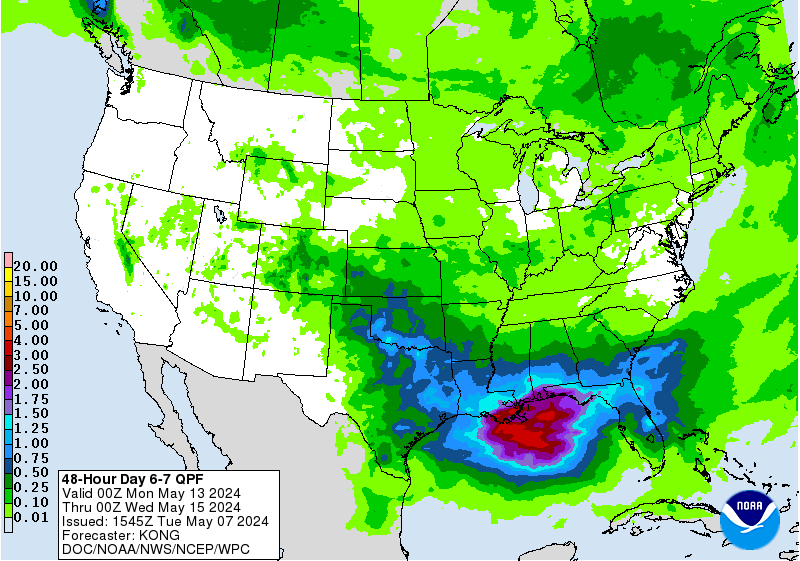
» Extreme Precipitation Monitor
+ Additional Links
- » Product Verification
- » Product Archive
- » Product Info
- » Additional formats of QPF: GRIB 2 | Shapefiles | KML
- » Other QPF Products
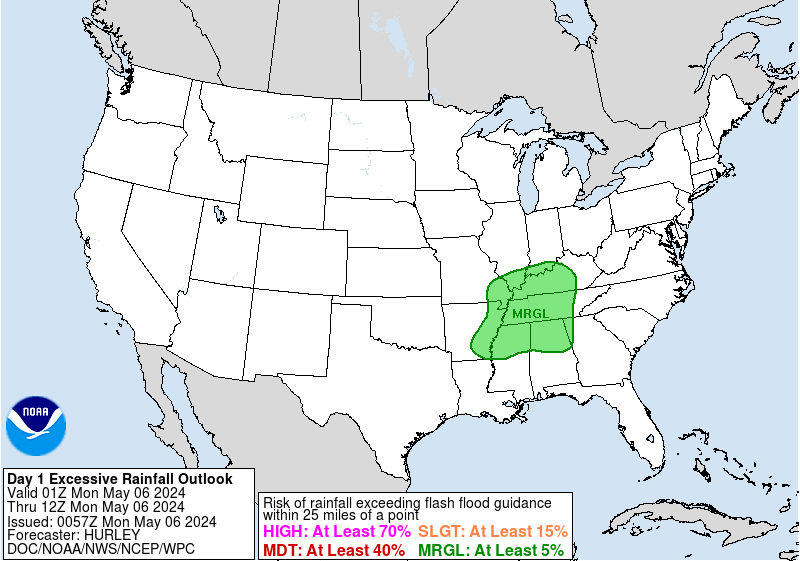
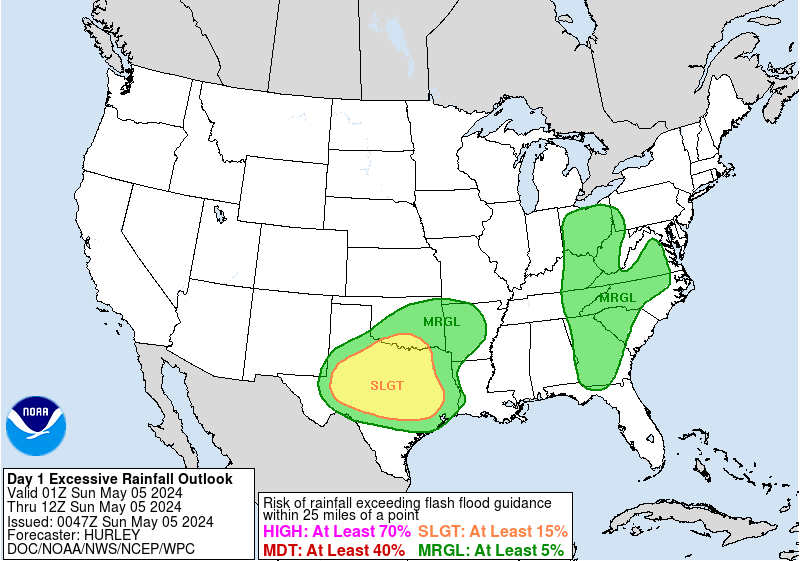
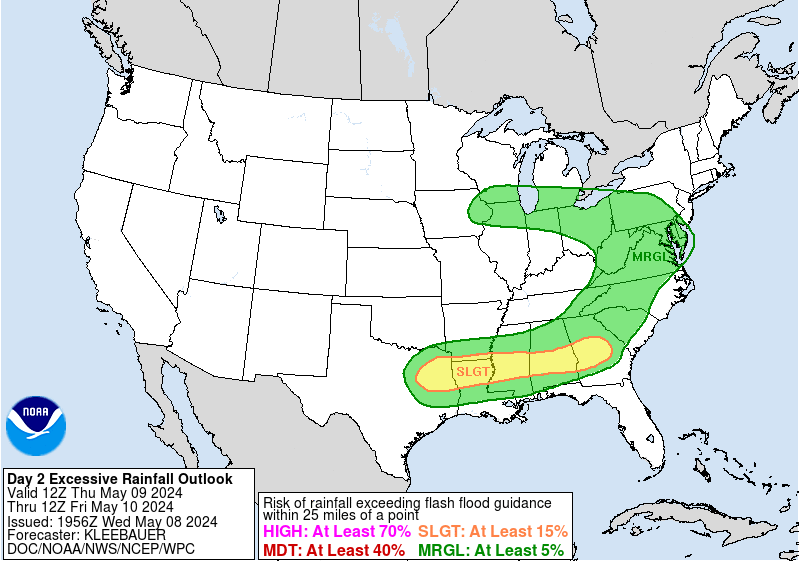
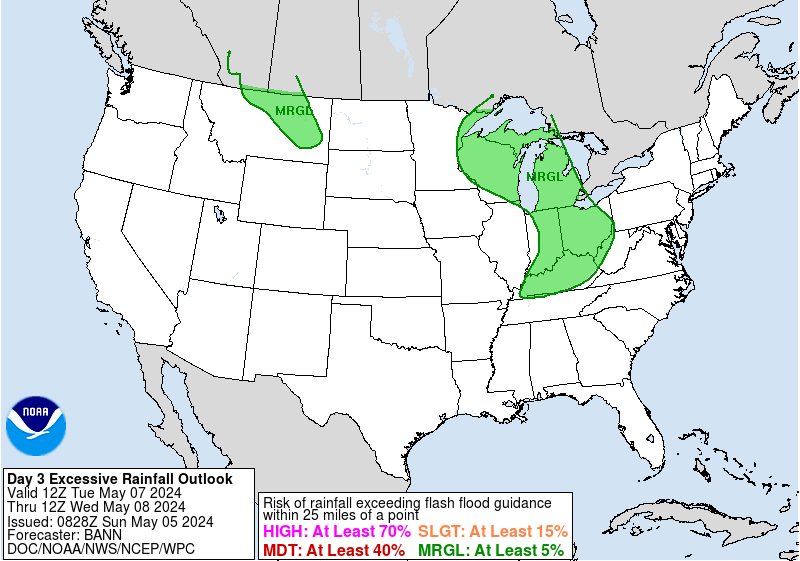

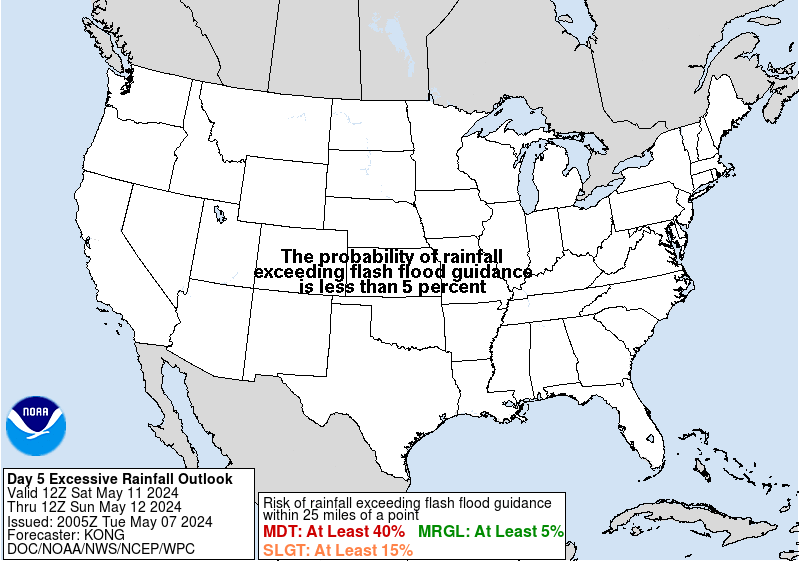
+ Forecast Discussion
Excessive Rainfall Discussion
NWS Weather Prediction Center College Park MD
750 PM EDT Sun Jul 21 2024
Day 1
Valid 01Z Mon Jul 22 2024 - 12Z Mon Jul 22 2024
...THERE IS A SLIGHT RISK FOR EXCESSIVE RAINFALL ACROSS PORTIONS OF
THE SOUTHWEST AND THE WESTERN CAROLINAS...
...Western Carolinas...
Some southward shift to the Slight Risk area was done per radar and
18z HREF trends. Another round of scattered to widespread
convection is ongoing in and near the Carolinas with some
locations setup to see a greater emphasis for heavy rainfall. A few
weak mid- level perturbations will advect northeast within the
mean flow. The coupling of increased upper support with a strong
diurnal destabilization pattern has promoted the threat of
stronger cell cores with heavy rain potential due to anomalous
moisture lingering along and south of the quasi- stationary front
to the north. Convection firing along the terrain of the
escarpment up through the Appalachians of NC should drift to the
east towards lower elevations. Locally enhanced rainfall exceeding
2" in an hour remains high for much of Western NC down into the
far Upstate portion SC to the north of GSP in the short term.
This area has seen its fair share of heavy rain in the past 24-48
hrs at times, so the latest FFGs are lower than climo.
...Southwest and Southern Rockies...
Divergence aloft between an upper low offshore the Northwest and an
upper level trough across the Plains combined with daytime heating
has led to convective development in- of the Southern Rockies and
adjacent terrain of NM due to primed environmental destabilization
coinciding with a progression of mid- level vortices streaming down
the eastern flank of the ridge across the Western U.S. A slight
weakening of the ridge will allow for an expansion of the
convective threat to migrate westward into the Mogollon Rim with
some deterministic output signaling some formidable amounts within
the terrain. The primary areas of interest within the current SLGT
will reside within the complex terrain and areas surrounding the
remnant burn scars located within the Sacramento's and Sangre de
Cristos. Secondary areas of focus include the NM Bootheel,
Southeast AZ terrain around the Huachucas, as well as the Eastern
NM High Plains into the Northwest Permian Basin of Texas.
The latter of the aforementioned areas has a focus along a remnant
outflow that bisect the Caprock down into the Permian Basin,
outlined by a marginal theta-E gradient in place from Clines
Corner, NM down close to I-20 around the Midland/Odessa corridor. A
shortwave currently analyzed over CO will continue to make headway
to the south around the eastern flank of the ridge eventually
aiding in convective initiation across east-central NM by the
afternoon. Multi-cell clusters of thunderstorms have been
congealing and driven south by prevailing cold pools, riding right
along the theta-E gradient. Storms will be able to hold together
and impact a large area encompassing the Caprock of Eastern NM down
through the Northwest Permian Basin before potentially collapsing
tonight. There is a chance this holds together to the I-20
corridor and provides some heavier rain within the confines of the
Midland/Odessa area, but the probability is lower compared to the
Northwestern areas up across Southeastern NM up through the Caprock
along the TX/NM state lines. Despite a very dry signal within the
soil moisture availability over the region, rainfall rates in
excess of 1.5"/hr will be plausible given the elevated moisture
presence as noted within the latest NAEFS PWAT anomalies
approaching 1-1.5 deviations above normal across much of Southeast
NM extending southeastward into the quasi-stationary front aligned
near I-10. Some adjustments were made due to radar reflectivity and
18z HREF trends.
...Oklahoma...
A compact but well-defined surface wave will linger
within the base of the mean trough carved out across the Mid-
Mississippi Valley back down into the northern fringes of the
Southern Plains in OK. Signals for increasing low-level
convergence within the confines of low are present, leading to a
narrow corridor of heavy rain that could see totals breach 4"
within a short period of time. The main threat is confined within
the small circulation with the northern fringes of the low being
the prime focus for where modest training could occur. The areal
extent of flash flood concerns is small due to the compact nature
of the setup.
Roth/Kleebauer
Day 1 threat area: www.wpc.ncep.noaa.gov/qpf/94epoints.txt
Excessive Rainfall Discussion
NWS Weather Prediction Center College Park MD
422 AM EDT Mon Jul 22 2024
Day 1
Valid 12Z Mon Jul 22 2024 - 12Z Tue Jul 23 2024
...THERE IS A SLIGHT RISK FOR EXCESSIVE RAINFALL ACROSS PORTIONS OF
THE SOUTHERN ROCKIES, SOUTHERN PLAINS, MID ATLANTIC, AND THE
CAROLINAS...
...Southern Plains...
A quasi-stationary front will bisect much of TX during the period
with a succession of mid-level disturbances entering the region
beginning later this morning, carrying through the rest of the
period as they pivot south-southeast around the western flank of a
mean trough to the north. A deep moisture presence will be situated
across Southwest TX through points east with a stronger low-level
convergence pattern and favorable anomalies tied to the lingering
front. Scattered convection will form across the Davis Mountains
and Stockton Plateau in the early afternoon time frame with cells
across the Edwards Plateau initiating not long after. Considering
the moist anomalies and relatively slow storm motions off the
terrain, some cells will be able to produce locally enhanced
rainfall with rates between 1-2"/hr on average with some of the
stronger cores capable of breaching 2"/hr anywhere across the
aforementioned area(s). Numerous multi-cell clusters will develop
by mid-afternoon with outflow generation likely considering the
higher DCAPE environment forecast across the western half of TX.
Outflow propagation will make progress to the east with more cell
initiation forming in the favorable environment away from the cold
pools.
Storms should develop initially over Hill Country to the
I-35 corridor, but more organized convective clusters will enter
the picture by early evening leading to more widespread heavy rain
chances and flash flood concerns as rates can sufficiently hit
2-3"/hr as reflected in the HREF hourly rate probability fields.
There's a very high spatial coverage of higher probabilities for at
least 1" of rainfall in the HREF EAS fields (30-50%) with the
neighborhood probabilities for at least 3" and 5" depicting a
formidable areal extent of 60-80% and 25-40% respectively for each
threshold. There's even some low-end >8" probabilities reflected in
the HREF output as well, indicative of a locally significant impact
potential across portions of Western and Central TX. The best
probabilities lie within the Edwards Plateau through Hill Country
with a small bullseye showing up in the means to the I-35 corridor.
This is well within the bounds of a SLGT risk with higher end SLGT
risk wording necessary for the current forecast. There is a non-
zero chance for an upgrade somewhere across the above region, but
there is less of a true, organized heavy rain risk to pinpoint, but
the area that will be impacted will see those locally significant
flash flood concerns arise.
...Mid Atlantic and Carolinas...
Persistent troughing to the northwest across the Great Lakes will
edge eastward with southwesterly flow and increasing diffluence for
much of the Mid Atlantic and Carolinas, moving into the Northeast
U.S by the back end of the period. At the surface, a lingering
quasi-stationary front will settle over the VA Tidewater down
through the Carolina's and points west with a stronger low-level
convergence footprint tied to the boundary. PWAT anomalies of 1-2
deviations above normal will spread north as we see a bit more
backing of the flow within the Mid Atlantic with the strongest ties
across the Southern Mid Atlantic thanks to a surface wave riding up
the front once again, reaching the VA/NC coastal areas by the late
afternoon hours.
The area(s) of highest interest are located across the VA Tidewater
and adjacent Northeast NC, the eastern side of the Carolina
Piedmont, and up into the Susquehanna Valley of PA where the HREF
neighborhood probability fields are all lit up for the potential
of seeing >3" in spots with even a strong >5" signature located
along the I-64 corridor in Southeast VA (50-60%). The increased
upper forcing due to better aligned mid-level diffluence and some
right-entrance region of a developing upper jet streak just off to
the north will allow for a blossoming of scattered convection
across portions of the Mid Atlantic through Central PA. The primary
initiation points will likely be tied to the terrain at first, but
as cells propagate off the terrain, they will experience some
modestly favorable shear that would help sustain updrafts that
could lead to stronger cell cores and locally heavy rainfall. PWAT
anomalies are most favorable for heavy rain along and east of the
I-99 and US-15 corridors leading to a lot of CAMs members
ratchetingup the potential with isolated pockets of 2-4+" totals
within the deterministic output, and reflected in the HREF blended
mean data set showing the expanse of higher totals and increasing
flash flood concerns. The threat will also reside within the urban
corridor from DC to Philadelphia, but there is some disagreement
within the CAMs on the potential due to a small cull in the precip
field with initiation away from the major metro areas. The UFVS ML
First Guess Field is still insistent on a widespread SLGT risk
through the urban areas extending all the way up to the PA/NY
border. The QPF footprint within ML output is also insistent on
potential maxima within the metro areas, so the best course of
action was have that area within the new SLGT risk proposal with
areas to the north into PA outlined as well given the better
signals and agreement in the First Guess Fields.
Further south into Southeast VA and the Carolinas, the threat is
more defined thanks to the presence of the stationary front leading
to ample low-level convergence potential coinciding with fairly
stout theta-E indices located along and south of I-64. The highest
threat will reside over the Hampton Roads area up to Williamsburg
where several days of heavy rainfall have degraded the FFG indices
considerably leading into today. This signal of degraded indices is
documented down through the NC Piedmont all the way into Columbia,
SC where back-to-back days of significant convective impact have
led to flash flooding reports all across southern and central SC.
The threat for today extends into those areas again thanks to weak
mid-level perturbations ejecting northeast within the mean flow
correlating with the stationary front to provide another focused
area of heavy thunderstorms from basically the GA/SC border and
points northeast. As a result, the SLGT risk addition was also
extended to include part of the Delmarva down through Southeast VA
into portions of the Central and Eastern Carolinas.
...Southwest and Southern Rockies...
Continued Monsoonal convective pattern will impact the Desert
Southwest this period with focus along the terrain in AZ and NM,
including the hotter spots of the Mogollon Rim over into the Sangre
de Cristos and the Sacramento Mountain chains. Probabilities
continue to be modest for 1-2" maxima with some higher end
potential in stronger cores that linger within the terrain. The
continued mid and upper ridging in place has led to slower storm
motions with some training concerns under the weak mean steering
flow. Considering the onslaught of scattered to widespread
convection for the past several periods leading to many Flash Flood
Warning issuances by the WFOs across the Southwest, another SLGT
risk was maintained within the Southern Rockies where the impact
potential is highest thanks to remnant burn scars and persistent
flooding over the past week. A MRGL extended to much of the
Southwestern U.S with the Mogollon Rim as the secondary candidate
for higher totals and impacts for localized flash flooding
concerns. The threat probabilistically is still on the middle to
high end of MRGL for the aforementioned area, but a short term
upgrade is plausible if coverage ends up more sufficient than
currently forecast.
...Upper Midwest...
Shortwave trough across Manitoba will pivot southeast into the
Arrowhead of MN with increasing large scale ascent and accompanying
positive vorticity advection (PVA) within the confines of the area.
Relatively steep mid-level lapse rates within a corridor of modest
instability will result in scattered thunderstorm initiation once
the disturbance crosses the border into the U.S. Progressive storm
motions will limit the threat of flash flooding to more isolated
signals, however some heavier cores with rates between 1-2"/hr will
be plausible given some of the low-end probabilities within the
latest HREF output. Totals are generally within the 0.5-1" in areal
coverage, but the matched mean does indicate a few cells capable of
dropping 2-3" near the northern shores of Lake Superior, including
near DLH where urban flooding is more probable. A MRGL risk was
introduced in coordination with the local Duluth WFO for low-end
flash flooding concerns, but enough to warrant the targeted risk.
Kleebauer
Day 1 threat area: www.wpc.ncep.noaa.gov/qpf/94epoints.txt
Excessive Rainfall Discussion
NWS Weather Prediction Center College Park MD
422 AM EDT Mon Jul 22 2024
Day 2
Valid 12Z Tue Jul 23 2024 - 12Z Wed Jul 24 2024
...THERE IS A SLIGHT RISK FOR EXCESSIVE RAINFALL ACROSS PORTIONS OF
CENTRAL AND SOUTHEAST TEXAS...
...Texas...
Quasi-stationary front will push north and eventually wash out
across the Southern Plains as surface ridging across the Gulf
begins flexing more northwest allowing for deeper moisture presence
to advect into Southeast TX. Scattered convection will develop from
the Lower Trans Pecos through all of Central TX by the afternoon
due to diurnal destabilization with lingering outflow boundaries
from previous periods convection becoming a potential focal point
for heavy rainfall and training over much of the area. Areal QPF
averages are between 0.5-1" across West-Central and Central TX with
some of the upper quartile outcomes closer to 3-4" within different
deterministic forecasts. This seems to be towards the upper
threshold of the potential across the region, but after what is
expected today, there's expected to be a lingering flash flood
threat after much of the area becoming primed from previous
rainfall. This was sufficient for a maintenance of the previous
SLGT risk.
Further to the southeast, the additional surge of low-level
moisture out of the Gulf will be accompanied by a weak mid-level
disturbance that will advect north out of the Bay of Campeche,
already causing some convective flare ups down that way when
assessing the latest IR satellite. Ensemble means are becoming more
bullish on the threat of heavier rainfall tied to the Middle and
Upper TX coast with some deterministic outputs pushing 3-5" between
Corpus to the far Upper TX coast, including coastal Houston.
The threat is gaining favorable within the ensemble probability
fields as well with the NBM now depicting a 25-40% chance of >2"
within the zone encompassing Matagorda up towards Port Arthur.
Considering this is working off the mean QPF of the blend, that is
impressive at 2-day leads. The extension of the SLGT was made to
encompass that area of the coast from CRP up to the Southwestern
corner of LA.
...Southwest and Southern Rockies...
Scattered convection will occur once again across much of the
Southwestern U.S with isolated threats of flash flooding within the
flashy complex terrain, remnant burn scars, and slot canyons
located within the Great Basin. The ridge axis will shift a bit
further to the west aligning more of the convective potential
through eastern CA and much of NV leading to more coverage of the
MRGL risk across those areas. QPF means are generally light, but
some of the higher end outputs within the deterministic suite are
upwards of 1-2", especially across the Mogollon Rim. This is a
classic Monsoonal setup with the favored terrain being the primary
focus for the period. The MRGL risk inherited was maintained with
full continuity as ensemble mean QPF did not change much in terms
of magnitude and precip placement from previous forecast.
...Midwest...
Shortwave trough over the Northern Great Lakes will dip further
southeast with trailing mid-level vorticity pivoting around the
base of the trough situated over Ontario. Scattered cells in the
more will move southeast, but lose fervor as they enter into MI. A
secondary pulse of convection is expected later Tuesday with a more
organized area of thunderstorms expected to form upstream near Lake
Superior, dropping southeast through WI and the western portions of
the UP. The storms will remain on the progressive side, but the
threat of rates up to 2"/hr could cause some isolated flash flood
concerns in more urbanized zones over Central and Eastern WI. This
includes places like Green Bay, Northern Milwaukee, Oshkosh, and
Sheboygan. The previous MRGL risk was maintained with some minor
adjustments on the western flank of the risk area to account for
QPF shifts in the ensemble means.
...Southeast through the Northeast U.S...
Scattered thunderstorms will continue across the Southeast all the
way up into the Northeastern U.S thanks to persistent synoptic
scale forcing and a relatively modest thermodynamic environment in
place. Smaller mid-level perturbations will be entrenched in the
mean flow and will help trigger some smaller, organized cell
clusters capable of isolated flash flooding basically extending
from the Deep South into the Mid Atlantic. Any cell generation
in the deep, moist environment will be capable of flash flooding
concerns with the highest threat likely within the Carolina's due
to the antecedent wet conditions in place over much of the eastern
2/3's of the region. A broad MRGL risk is in place extending from
the Southeast through the portions of the Northeastern U.S given
the threat.
Kleebauer
Day 2 threat area: www.wpc.ncep.noaa.gov/qpf/98epoints.txt
Excessive Rainfall Discussion
NWS Weather Prediction Center College Park MD
422 AM EDT Mon Jul 22 2024
Day 3
Valid 12Z Wed Jul 24 2024 - 12Z Thu Jul 25 2024
...THERE IS A SLIGHT RISK FOR EXCESSIVE RAINFALL ACROSS SOUTHEAST
TEXAS AND SOUTHWEST LOUISIANA...
...Texas and Louisiana...
Disturbance off the Gulf will continue to press north around the
western flank of the ridge located within the Gulf. There's some
discrepancy within the deterministic on the exact placement on the
core of the mid-level energy as it enters out of the coastal waters
into the U.S. Despite the lack of consensus on the where for the
energy, the deep moist advective pattern across Southeast TX into
portions of the Central Gulf Coast is not so much a question with
only where the general precip maximum will focus. There's growing
consensus that significant rainfall on the order of 2-5" with
locally higher will impact somewhere within the Middle and Upper TX
coast, over into Southwestern LA. ML output from the ECMWF AIFS and
GFS Graphcast are closely aligned to the Upper TX coast which makes
a bit more sense synoptically given the favored mid-level ridge
positioning and western weakness aimed for the Upper coastal areas.
The previous SLGT risk was not changed much due to the modest
uncertainty in the precip maximum with the setup, however the
threat is more on the higher end of the SLGT threshold due to the
potential for significant rainfall in any area of expected impact
with the highest impacts focused where the mid-level disturbance
makes its presence closely known. This is a period to monitor as an
upgrade to a higher risk is plausible considering the upper
quartile output of ensemble QPF and the tropical connection.
...Southern Rockies and Southwest...
Monsoonal convection will encompass much of the Southwest U.S with
primary coverage in the Great Basin as the mid-level ridge pattern
shifts focus to the west of the Four Corners. Modest moisture
anomalies and relatively formidable instability across much of the
region will allow for scattered thunderstorms with isolated heavy
rain cores that could spell issues if they fall along complex
terrain, burn scars, urban footprints, and slot canyons. A MRGL
risk is in effect across much of the climatologically favored
areas in the Southwestern Monsoon.
...Great Lakes and Ohio Valley...
Surface low will shift eastward over northern MI, eventually
pushing northeast into neighboring Ontario with a cold front
trailing the surface reflection. The combination of marginally
better upper forcing with increasing surface convergence in-of the
cold front moving eastward will create a period of scattered
showers and thunderstorm along and ahead of the front. Some
isolated pockets of heavier rainfall within the urban corridors
spanning from Chicago up through Southern MI will have the
opportunity for flash flooding as the system progresses through the
area. The signal is fairly weak overall and could very well fade
in later updates. Considering the synoptic pattern expected and
some time to delve into greater detail, maintained much of the
continuity in the forecast with some minor adjustments on the
northern flank of the risk area.
Kleebauer
Day 3 threat area: www.wpc.ncep.noaa.gov/qpf/99epoints.txt
NWS Weather Prediction Center College Park MD
259 AM EDT Mon Jul 22 2024
Expect episodes of locally heavy rainfall during the latter half of
the week within a broad corridor of enhanced moisture from
southern/eastern Texas to parts of the East Coast. On Thursday, the
best composite of guidance highlights the region from far southern
Virginia through the Carolinas into northern Georgia/southern
Appalachians for heaviest rainfall potential. These locations will
also have wet ground conditions from recent/forecast rainfall. Thus
the Day 4 Excessive Rainfall Outlook depicts a Slight Risk area
across this region, representing a southwestward expansion from
continuity. Within the broad surrounding Marginal Risk area
covering the South and East, the western Gulf Coast region looks to
be another area of somewhat higher potential for locally heavy
rainfall but with a more diffuse guidance signal at this time
precluding a Slight Risk for the time being. Activity over the
Northeast in association with an upper trough/cold front appears to
represent the lower end of the Marginal Risk range. Southeastward
progression of the cold front over the East should suppress the
moisture axis near the East Coast by Friday, yielding a band of
Marginal Risk from southern/eastern Texas through most of the
Carolinas in the Day 5 ERO. The latter region would be on the
higher end of that range, with just a little better guidance
clustering meriting a Slight Risk area. Beyond early Saturday,
northward extent of rainfall over the East becomes increasingly
uncertain due to guidance differences in important details aloft.
Monsoonal moisture will continue to support episodes of diurnally
favored convection over the Four Corners region into the Great
Basin, with some shifting of coverage over the course of the period
based on pattern evolution. Instances of flash flooding will be
possible, especially near steep terrain and burn scars. The Day 4
Excessive Rainfall Outlook valid on Thursday maintains continuity
with a Marginal Risk area covering parts of the southern Rockies
into the Great Basin, while portions of the Marginal Risk area in
the Day 5 ERO shift a bit eastward in concert with progression of
highest moisture anomalies and best instability. Embedded Slight
Risk upgrades appear likely at some point in future cycles, with
specifics depending on how guidance clusters relative to each other
and with sensitive burn scar areas/regions with wettest ground
conditions. By late week onward, some of this moisture may interact
with the front progressing across the northern Plains to produce
some areas of focused rainfall.
Expect the hazardous heat over the West during the short term to
moderate/decrease in coverage late this week while a separate area
of hot temperatures will settle over northern half of the Plains.
Parts of California and the Southwest may see highs up to 5-10F
above normal Thursday-Friday along with the experimental HeatRisk
index showing scattered areas of at least major risk of heat-
related impacts especially on Thursday. Meanwhile, the northern
High Plains should also see the most extreme heat on Thursday with
highs 10-20F above normal (with a few daily records possible) and
broad coverage of the major category in HeatRisk. After Thursday
expect the heat to shift a little east/southeast over the northern
half of the Plains and persist into early next week (plus 5-10F and
locally higher anomalies). Very warm temperatures may also spread
into the Great Lakes and Northeast by Sunday-Monday. In contrast,
the generally wet pattern over the South and vicinity will tend to
keep highs below normal from southern/eastern Texas into the
southern Mid-Atlantic late this week into the weekend. Coolest
anomalies with greatest persistence should be over Texas.
Rausch
NWS Weather Prediction Center College Park MD
259 AM EDT Mon Jul 22 2024
Expect episodes of locally heavy rainfall during the latter half of
the week within a broad corridor of enhanced moisture from
southern/eastern Texas to parts of the East Coast. On Thursday, the
best composite of guidance highlights the region from far southern
Virginia through the Carolinas into northern Georgia/southern
Appalachians for heaviest rainfall potential. These locations will
also have wet ground conditions from recent/forecast rainfall. Thus
the Day 4 Excessive Rainfall Outlook depicts a Slight Risk area
across this region, representing a southwestward expansion from
continuity. Within the broad surrounding Marginal Risk area
covering the South and East, the western Gulf Coast region looks to
be another area of somewhat higher potential for locally heavy
rainfall but with a more diffuse guidance signal at this time
precluding a Slight Risk for the time being. Activity over the
Northeast in association with an upper trough/cold front appears to
represent the lower end of the Marginal Risk range. Southeastward
progression of the cold front over the East should suppress the
moisture axis near the East Coast by Friday, yielding a band of
Marginal Risk from southern/eastern Texas through most of the
Carolinas in the Day 5 ERO. The latter region would be on the
higher end of that range, with just a little better guidance
clustering meriting a Slight Risk area. Beyond early Saturday,
northward extent of rainfall over the East becomes increasingly
uncertain due to guidance differences in important details aloft.
Monsoonal moisture will continue to support episodes of diurnally
favored convection over the Four Corners region into the Great
Basin, with some shifting of coverage over the course of the period
based on pattern evolution. Instances of flash flooding will be
possible, especially near steep terrain and burn scars. The Day 4
Excessive Rainfall Outlook valid on Thursday maintains continuity
with a Marginal Risk area covering parts of the southern Rockies
into the Great Basin, while portions of the Marginal Risk area in
the Day 5 ERO shift a bit eastward in concert with progression of
highest moisture anomalies and best instability. Embedded Slight
Risk upgrades appear likely at some point in future cycles, with
specifics depending on how guidance clusters relative to each other
and with sensitive burn scar areas/regions with wettest ground
conditions. By late week onward, some of this moisture may interact
with the front progressing across the northern Plains to produce
some areas of focused rainfall.
Expect the hazardous heat over the West during the short term to
moderate/decrease in coverage late this week while a separate area
of hot temperatures will settle over northern half of the Plains.
Parts of California and the Southwest may see highs up to 5-10F
above normal Thursday-Friday along with the experimental HeatRisk
index showing scattered areas of at least major risk of heat-
related impacts especially on Thursday. Meanwhile, the northern
High Plains should also see the most extreme heat on Thursday with
highs 10-20F above normal (with a few daily records possible) and
broad coverage of the major category in HeatRisk. After Thursday
expect the heat to shift a little east/southeast over the northern
half of the Plains and persist into early next week (plus 5-10F and
locally higher anomalies). Very warm temperatures may also spread
into the Great Lakes and Northeast by Sunday-Monday. In contrast,
the generally wet pattern over the South and vicinity will tend to
keep highs below normal from southern/eastern Texas into the
southern Mid-Atlantic late this week into the weekend. Coolest
anomalies with greatest persistence should be over Texas.
Rausch
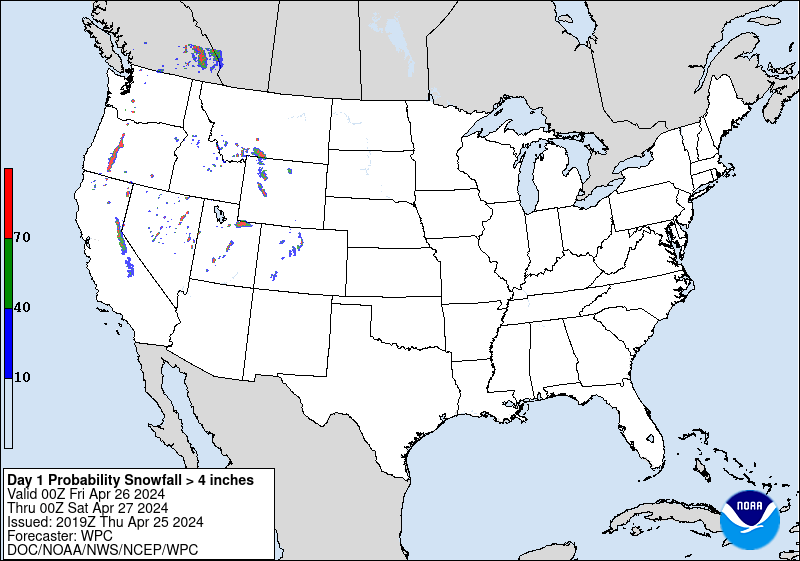
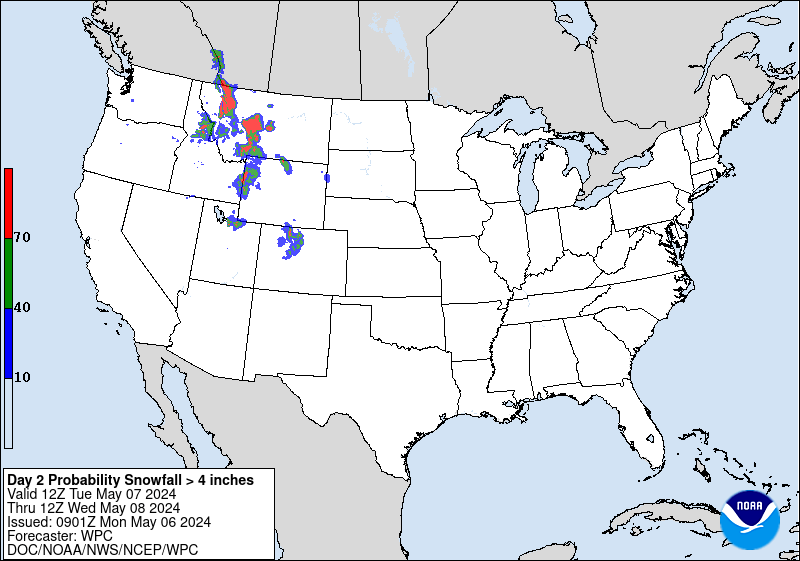
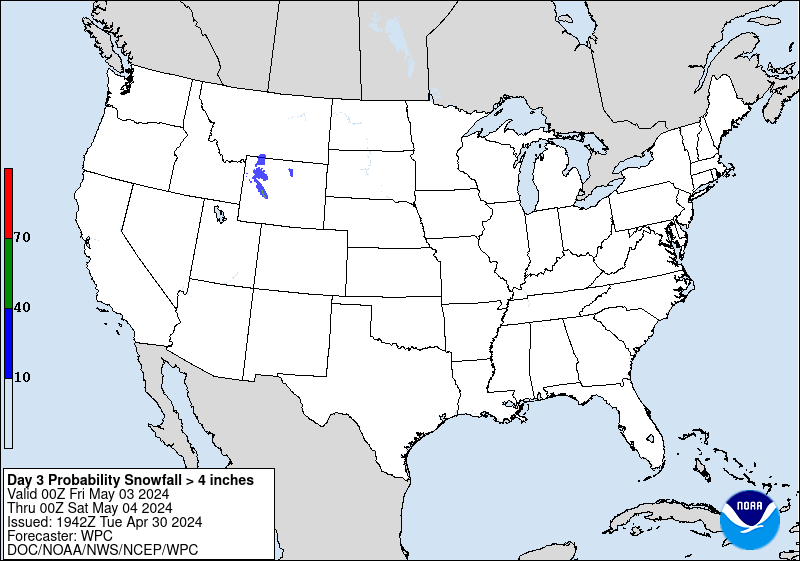
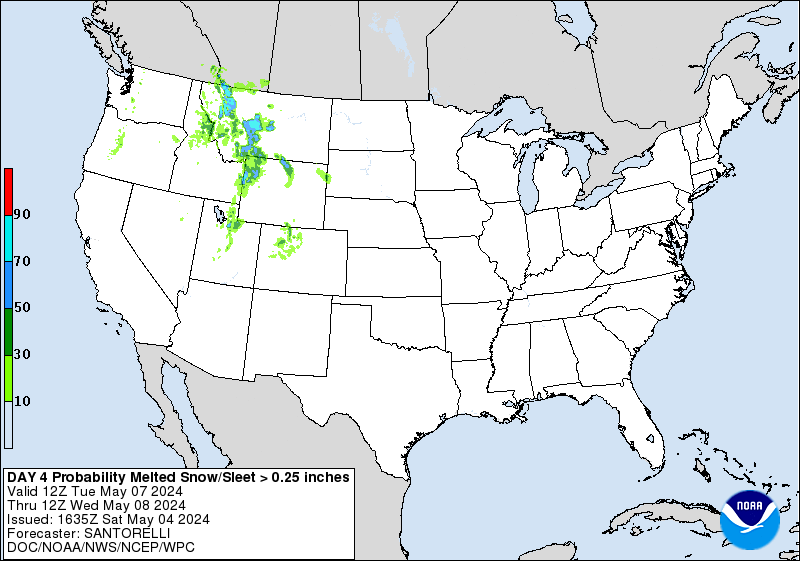
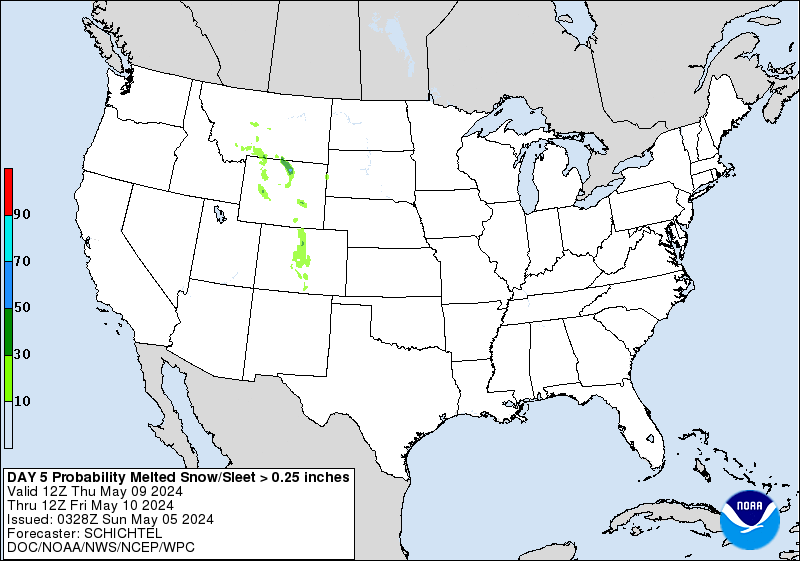
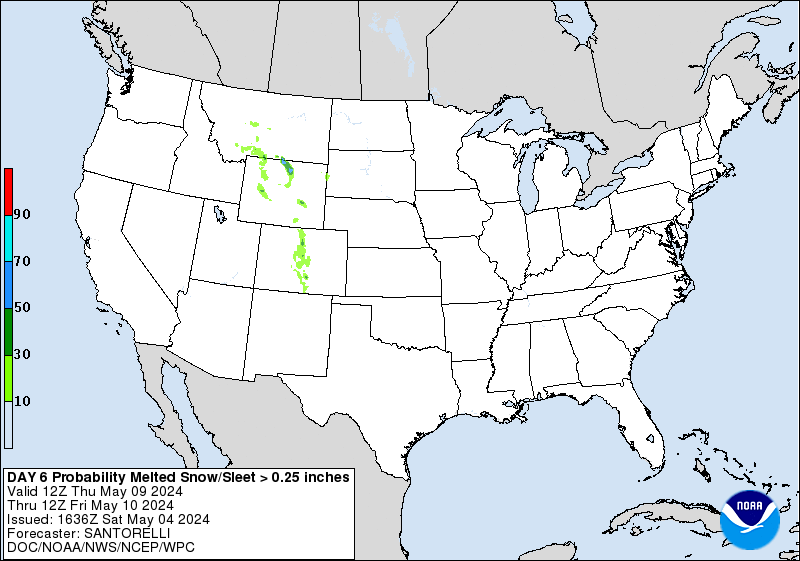
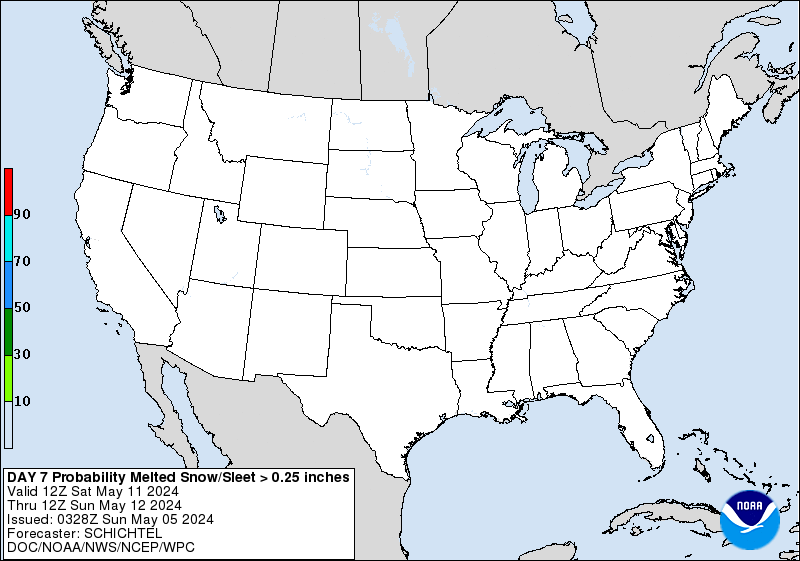
» Interactive Winter Weather Map (Day 4-7)
» Winter Storm Severity Index
+ Forecast Discussion (Day 1-3)
Probabilistic Heavy Snow and Icing Discussion
NWS Weather Prediction Center College Park MD
1251 PM EDT Mon May 20 2024
Valid 00Z Tue May 21 2024 - 00Z Fri May 24 2024
...WPC Winter Weather Desk no longer routinely staffed this
summer...
Pending any significant winter weather, the WPC Winter Weather Desk
will not be staffed this summer. The desk will resume continuous
staffing starting in late September 2024.
Most of the winter products from WPC will continue to be produced,
including the Winter Storm Severity Index (WSSI), Probabilistic
Winter Storm Severity Index (WSSI-P), and the Probabilistic Winter
Precipitation Forecasts (PWPF).
WPC
- » Experimental Winter Storm Outlook
- » Probabilistic Winter Storm Severity Index
- » Product Verification
- » Product Archive
- » Product Info
- » Forecast Surface Low Positions: Uncertainty Circles | Ensemble Clusters
- » Other Winter Weather Products
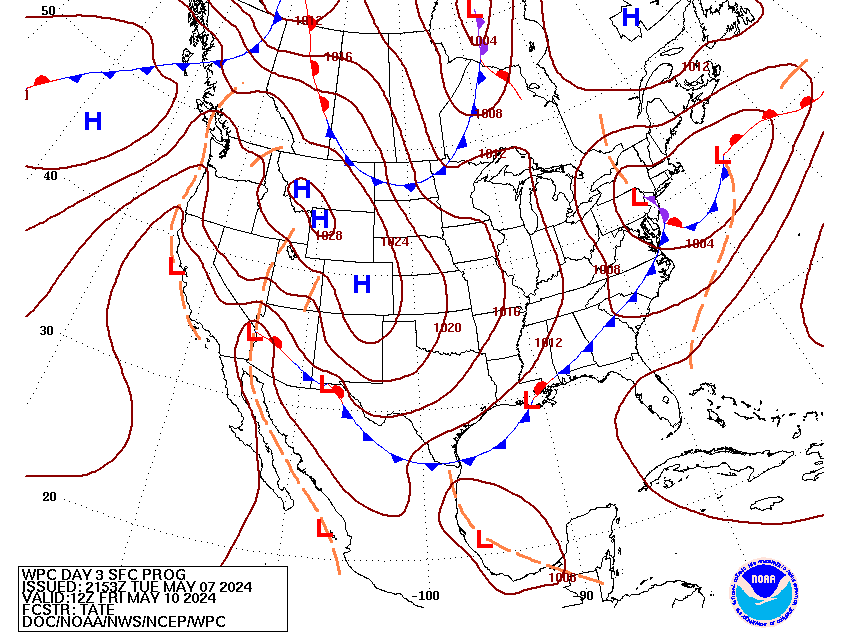
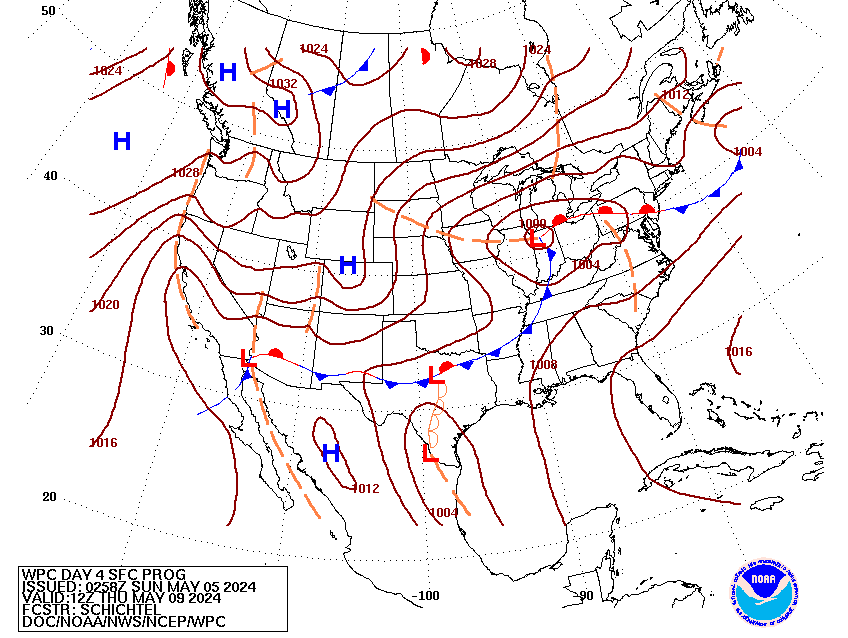
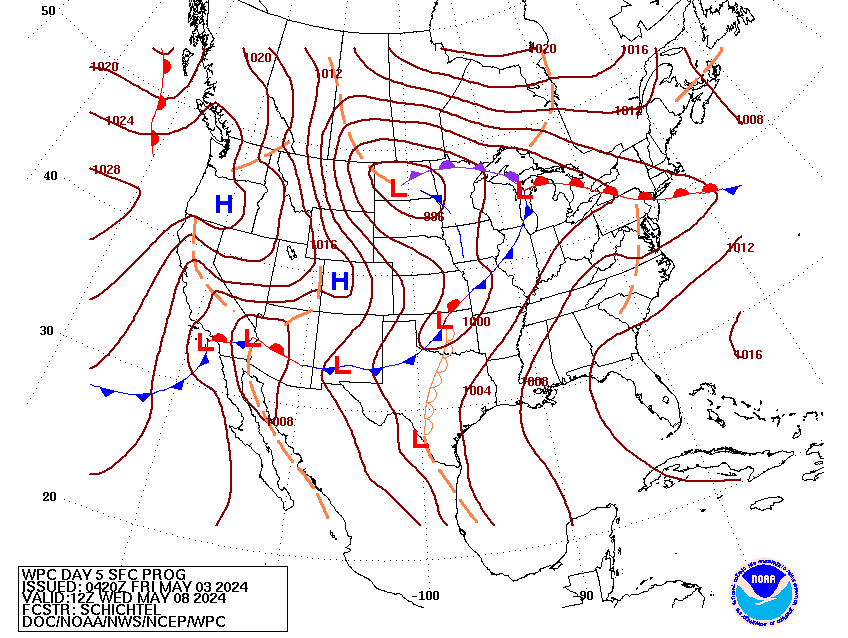
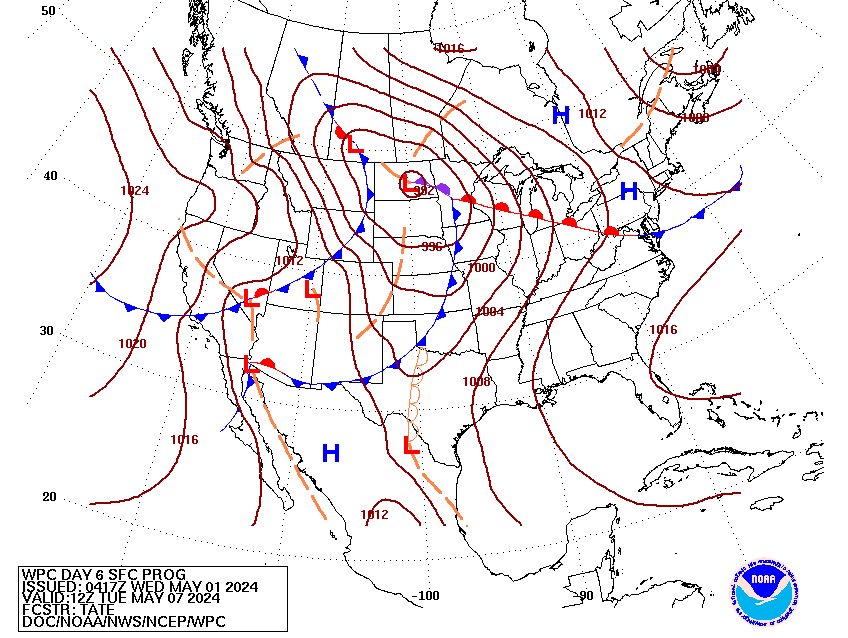
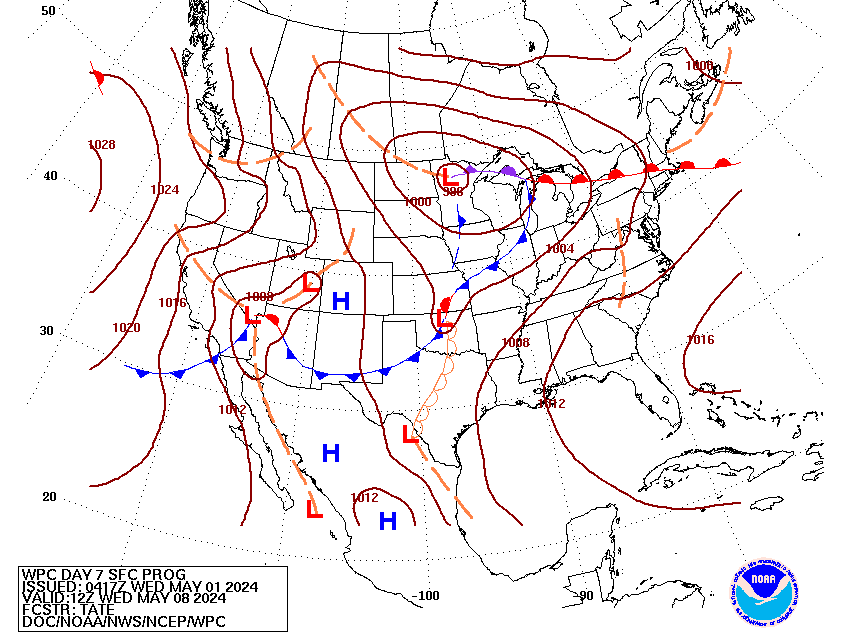
NWS Weather Prediction Center College Park MD
259 AM EDT Mon Jul 22 2024
Valid 12Z Thu Jul 25 2024 - 12Z Mon Jul 29 2024
...Western U.S. heat to shift into the northern High Plains...
...Showers/storms with locally heavy rainfall expected over the
Four Corners and from the western Gulf Coast into parts of the
East...
...Overview...
Guidance continues to show an evolution toward a more average
summertime pattern with flatter flow setting up over the northern
tier U.S. underneath and in the wake of an upper low tracking
across southern Canada, while moderate mean troughing lingers near
the West Coast. Farther east, there is initially good agreement
with an upper trough progressing eastward from the Great Lakes
(with a leading cold front). However disagreements arise regarding
residual trough energy near or offshore the East Coast, as well as
for what becomes of energy within an upper weakness over the Plains
late this week into the weekend. Initial western ridging should
weaken somewhat but linger over the Four Corners, while upper
ridging over the Southeast/Gulf coast should oscillate in strength
during the period. The forecast pattern will likely favor highest
rainfall totals from the western Gulf Coast into the southern Mid-
Atlantic as well as multiple days of locally heavy monsoonal
convection over and near the Four Corners states.
...Guidance/Predictability Assessment...
The primary guidance differences/trends of note on the synoptic
scale are over the eastern half of the country into the western
Atlantic. Over the past 24-36 hours, guidance clustering has
improved for the upper trough initially progressing eastward from
the Great Lakes (with the aid of a faster/more open trend in ECMWF
runs). However a fair amount of spread develops for the character
of trailing shortwave energy that may feed into the trough and
linger into next week. While the 12Z ECMWF-initialized machine
learning (ML) models vary, they provide a general theme of an
intermediate solution between the western ECMWF and farthest
offshore GFS. Meanwhile both the dynamical and ML models vary
considerably for what becomes of energy within an initial Plains
weakness, ranging from some of this energy getting carried
eastward/northeastward (with corresponding expansion of rainfall
ahead of it) to very little progression but rather more ridging
over the East by next Monday. Lack of agreement in both types of
models would recommend a conservative blended approach for the time
being. Over the West, there is good agreement for the overall
pattern with most differences involving smaller scale shortwave
impulses that have low predictability several days out in time. The
updated forecast based on 12Z/18Z guidance incorporated an
operational model composite early in the period and then a
transition to nearly half total weight of the 18Z GEFS/12Z ECens
means by next Monday.
...Weather/Hazards Highlights...
Expect episodes of locally heavy rainfall during the latter half of
the week within a broad corridor of enhanced moisture from
southern/eastern Texas to parts of the East Coast. On Thursday, the
best composite of guidance highlights the region from far southern
Virginia through the Carolinas into northern Georgia/southern
Appalachians for heaviest rainfall potential. These locations will
also have wet ground conditions from recent/forecast rainfall. Thus
the Day 4 Excessive Rainfall Outlook depicts a Slight Risk area
across this region, representing a southwestward expansion from
continuity. Within the broad surrounding Marginal Risk area
covering the South and East, the western Gulf Coast region looks to
be another area of somewhat higher potential for locally heavy
rainfall but with a more diffuse guidance signal at this time
precluding a Slight Risk for the time being. Activity over the
Northeast in association with an upper trough/cold front appears to
represent the lower end of the Marginal Risk range. Southeastward
progression of the cold front over the East should suppress the
moisture axis near the East Coast by Friday, yielding a band of
Marginal Risk from southern/eastern Texas through most of the
Carolinas in the Day 5 ERO. The latter region would be on the
higher end of that range, with just a little better guidance
clustering meriting a Slight Risk area. Beyond early Saturday,
northward extent of rainfall over the East becomes increasingly
uncertain due to guidance differences in important details aloft.
Monsoonal moisture will continue to support episodes of diurnally
favored convection over the Four Corners region into the Great
Basin, with some shifting of coverage over the course of the period
based on pattern evolution. Instances of flash flooding will be
possible, especially near steep terrain and burn scars. The Day 4
Excessive Rainfall Outlook valid on Thursday maintains continuity
with a Marginal Risk area covering parts of the southern Rockies
into the Great Basin, while portions of the Marginal Risk area in
the Day 5 ERO shift a bit eastward in concert with progression of
highest moisture anomalies and best instability. Embedded Slight
Risk upgrades appear likely at some point in future cycles, with
specifics depending on how guidance clusters relative to each other
and with sensitive burn scar areas/regions with wettest ground
conditions. By late week onward, some of this moisture may interact
with the front progressing across the northern Plains to produce
some areas of focused rainfall.
Expect the hazardous heat over the West during the short term to
moderate/decrease in coverage late this week while a separate area
of hot temperatures will settle over northern half of the Plains.
Parts of California and the Southwest may see highs up to 5-10F
above normal Thursday-Friday along with the experimental HeatRisk
index showing scattered areas of at least major risk of heat-
related impacts especially on Thursday. Meanwhile, the northern
High Plains should also see the most extreme heat on Thursday with
highs 10-20F above normal (with a few daily records possible) and
broad coverage of the major category in HeatRisk. After Thursday
expect the heat to shift a little east/southeast over the northern
half of the Plains and persist into early next week (plus 5-10F and
locally higher anomalies). Very warm temperatures may also spread
into the Great Lakes and Northeast by Sunday-Monday. In contrast,
the generally wet pattern over the South and vicinity will tend to
keep highs below normal from southern/eastern Texas into the
southern Mid-Atlantic late this week into the weekend. Coolest
anomalies with greatest persistence should be over Texas.
Rausch
Additional 3-7 Day Hazard information can be found on the WPC
medium
range hazards outlook chart at:
https://www.wpc.ncep.noaa.gov/threats/threats.php
WPC medium range 500mb heights, surface systems, weather grids,
quantitative precipitation forecast (QPF), excessive rainfall
outlook (ERO), winter weather outlook (WWO) probabilities, heat
indices, and Key Messages can be accessed from:
https://www.wpc.ncep.noaa.gov/medr/5dayfcst500_wbg.gif
https://www.wpc.ncep.noaa.gov/medr/5dayfcst_wbg_conus.gif
https://www.wpc.ncep.noaa.gov/5km_grids/5km_gridsbody.html
https://www.wpc.ncep.noaa.gov/qpf/day4-7.shtml
https://www.wpc.ncep.noaa.gov/#page=ero
https://www.wpc.ncep.noaa.gov/wwd/pwpf_d47/pwpf_medr.php?day=4
https://www.wpc.ncep.noaa.gov/heat_index.shtml
https://www.wpc.ncep.noaa.gov/#page=ovw
Displays flood and flash flood reports as well as intense rainfall observations for user-selectable time ranges and customizable geographic regions. Includes ability to download reports and associated metadata in csv format.
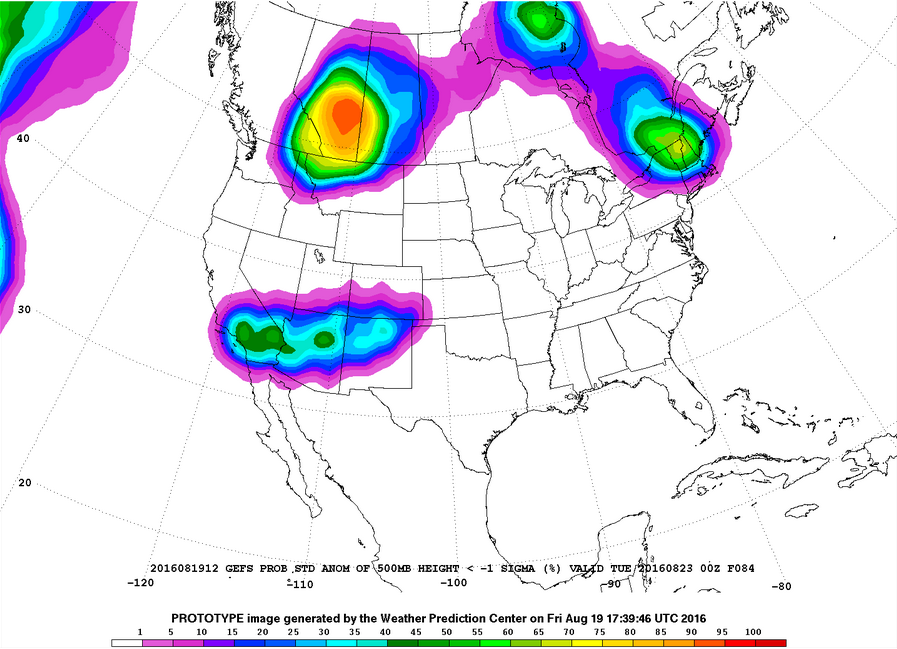
Plots of GEFS probabilistic forecast of precipitation, temperature, and sea-level pressure exceeding various thresholds.
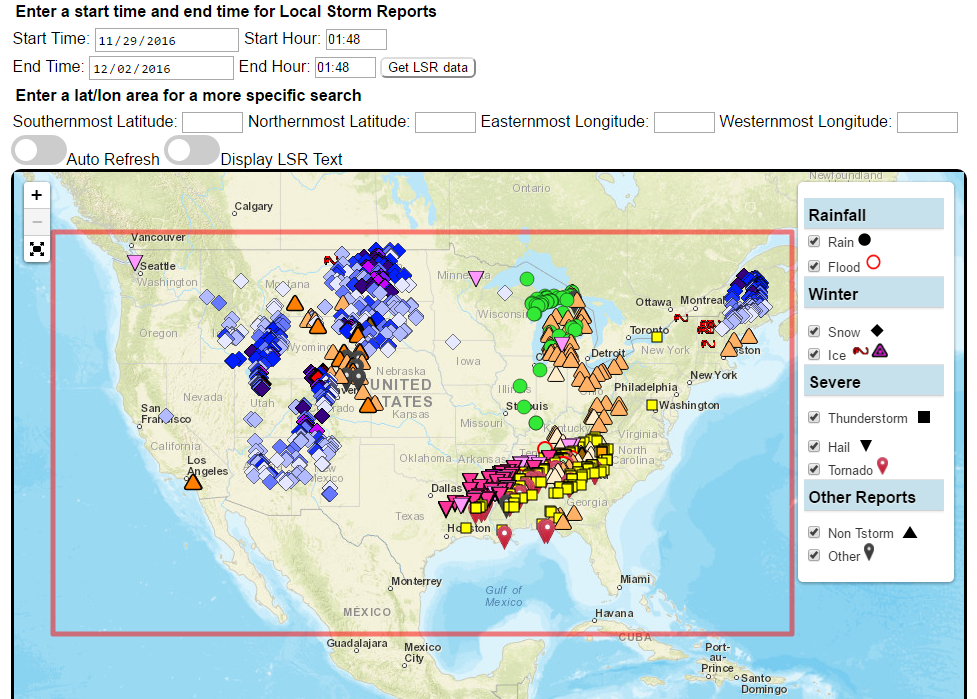
Custom plots of Local Storm Reports across the Contiguous United States. Reports include rain, snow, ice, and severe weather, as well as other significant information from storm spotters.
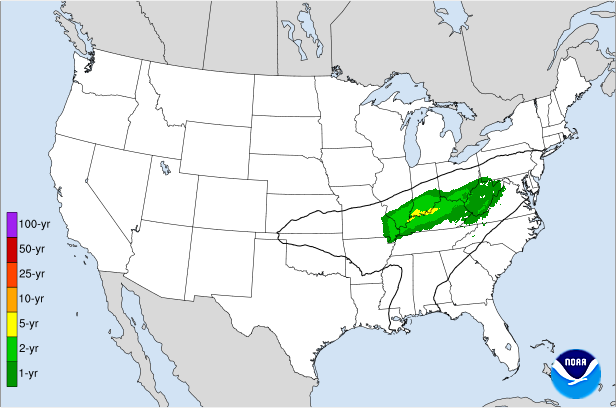
Displays the climatological significance of precipitation forecast by WPC. The climatological significance is represented by Average Recurrence Intervals (ARIs) of precipitation estimates from NOAA Atlas-14 and Atlas2.
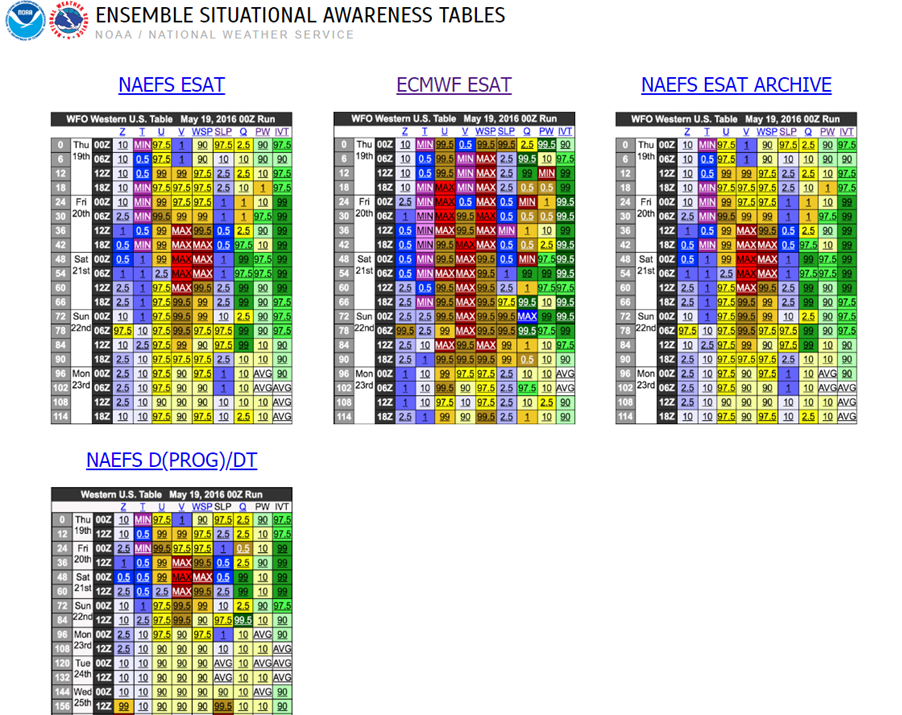
An interactive situational awareness table that displays anomalies, percentiles, and return intervals from the GEFS, NAEFS, and ECMWF Ensembles (login required to view ECMWF data).
*Please note that there is currently an issue where only users on a NOAA network can access this page. We are actively working to resolve this problem.
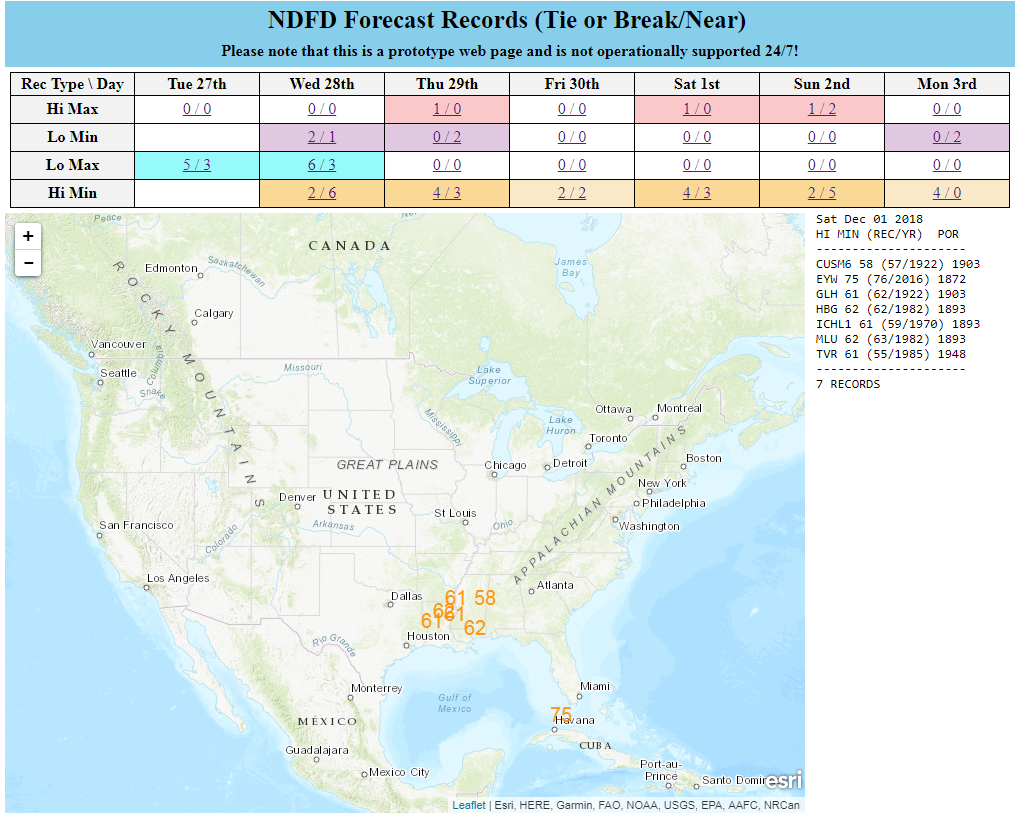
Interactive display of where temperatures could approach or exceed records within the contiguous U.S. (based on NDFD temperature forecasts)
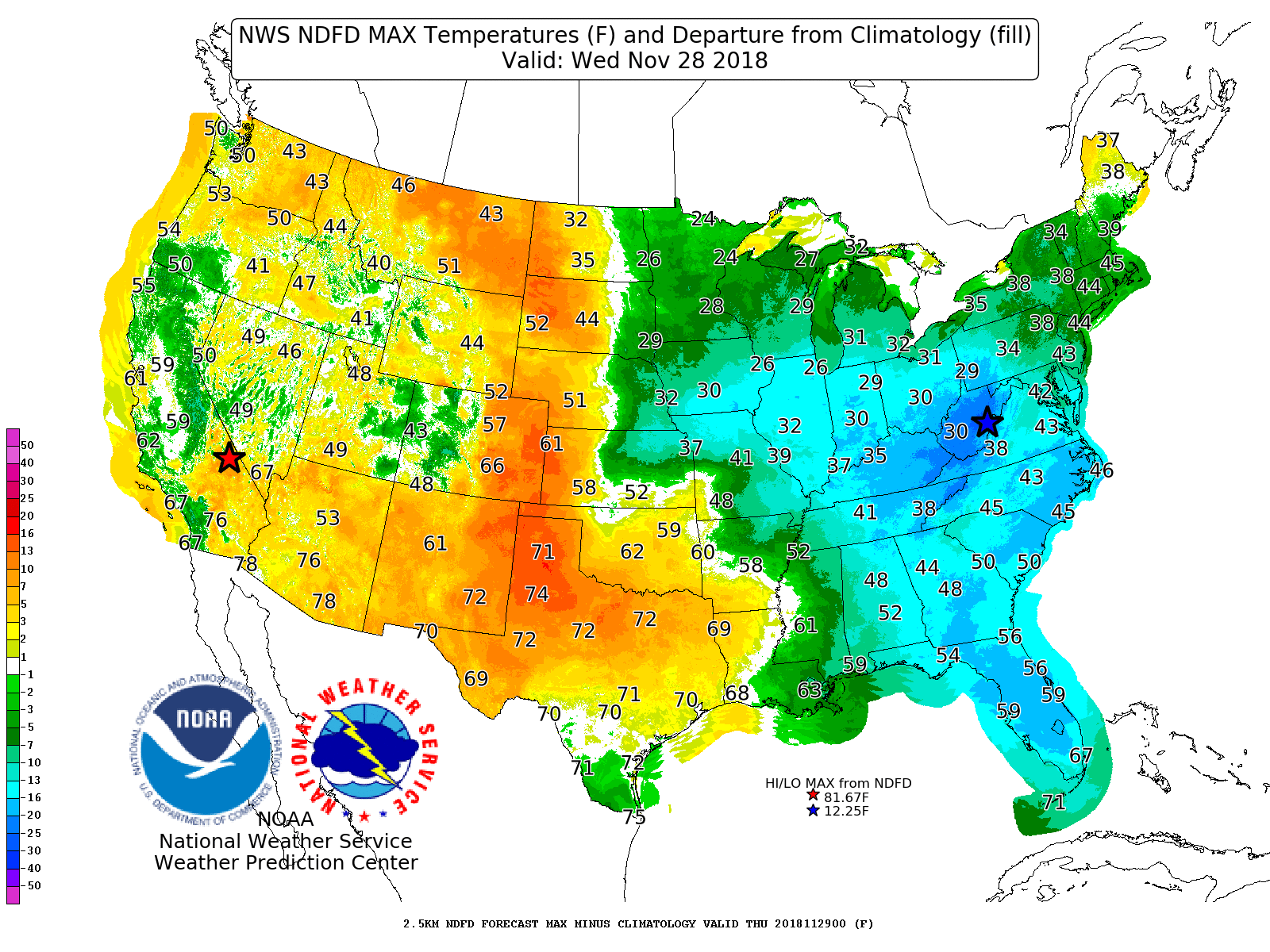
Displays Days 1-7 NDFD maximum and minimum temperatures, along with their respective departures from climatology.
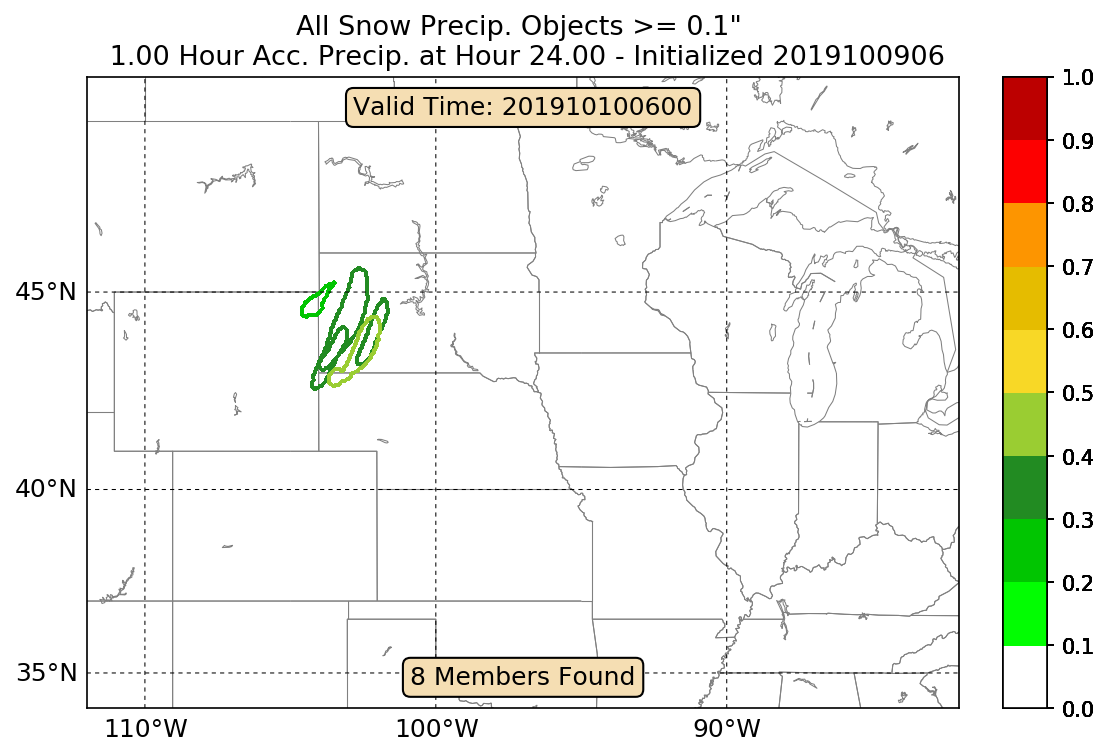
An interactive tool that depicts areas of heavy snowfall from individual members of high-resolution short range ensemble forecasts.
Displays forecast information and its climatological context to quickly alert a forecaster when a record or neear-record breaking event is possible. This tool is available for both CONUS and Alaska.
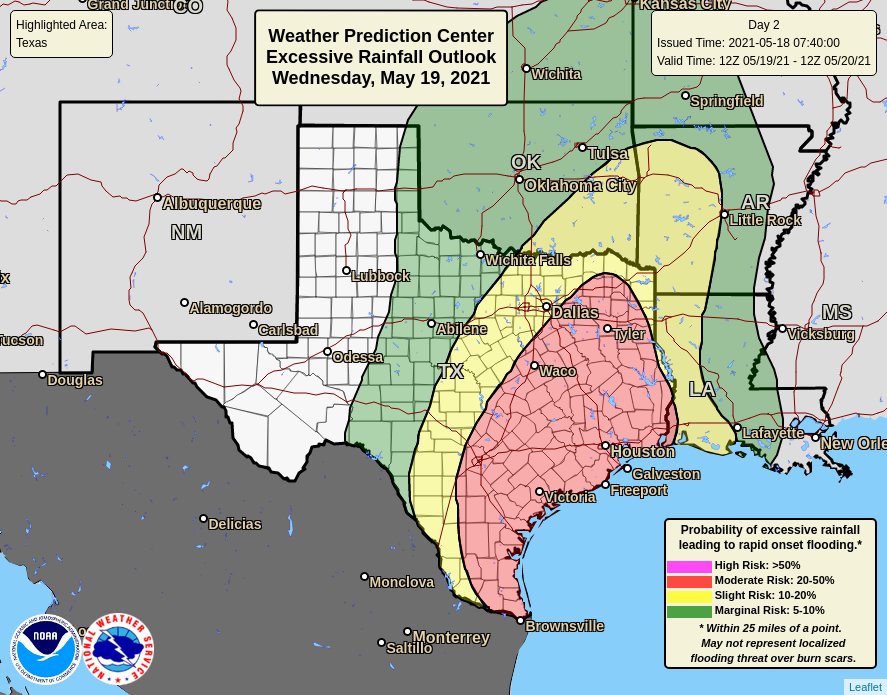
Interface for specialized WPC Excessive Rainfall Outlook Maps for NWS County Warning Areas and States.
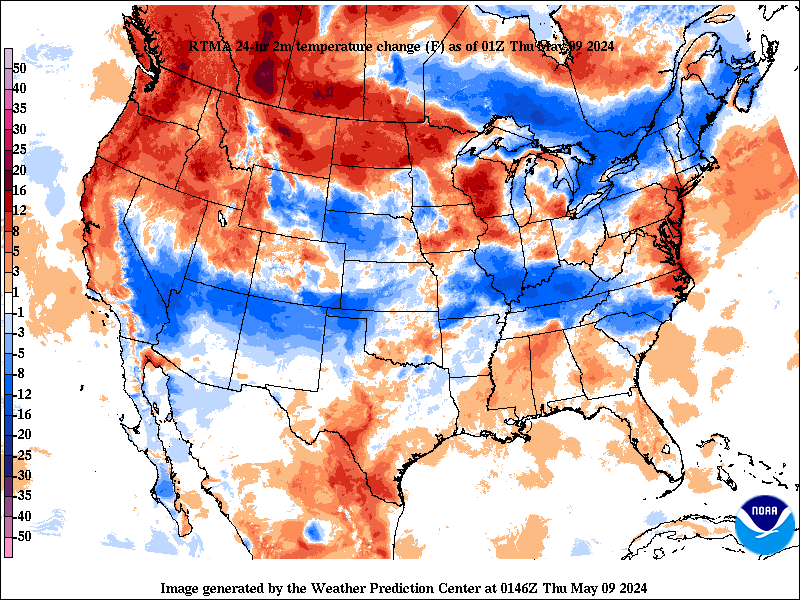
Change in weather parameters (temperature, dewpoint, surface pressure, etc) over the last 1/3/6/24 hours. Data is provided from the Real-Time Mesoscale Analysis (RTMA) or the Rapid Refresh (RAP).

The experimental National Weather Service (NWS) HeatRisk is a color-numeric-based index that provides a forecast of the potential level of risk for heat-related impacts to occur over a 24-hour period, with forecasts available out through 7 days.
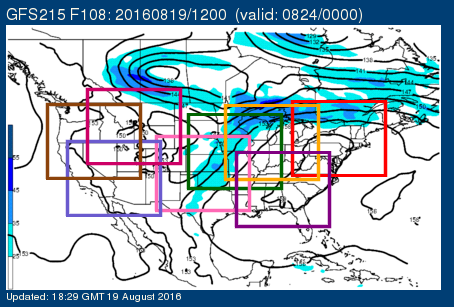
Analog guidance that uses an objective approach to find historical events that are similar to the upcoming forecast.
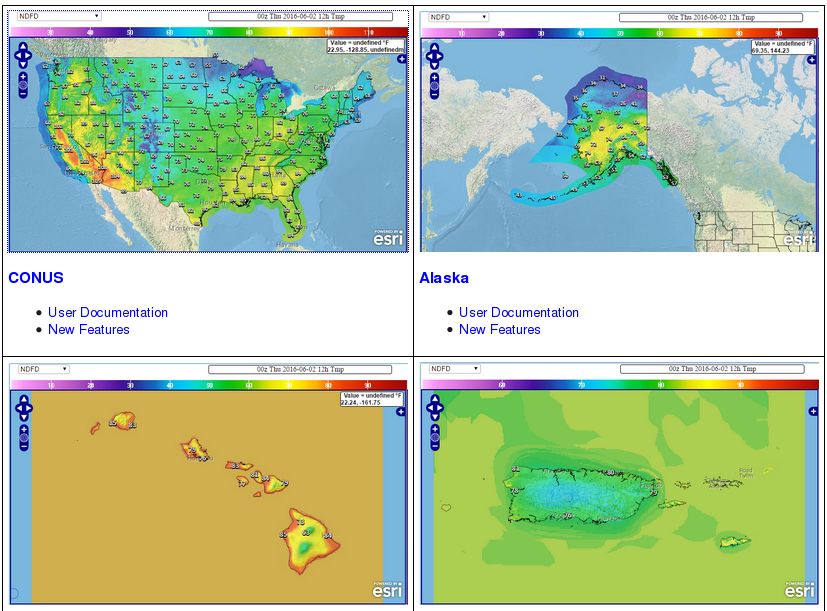
Nationally consistent and skillful suite of calibrated forecast guidance based on a blend of both NWS and non-NWS numerical weather prediction model data and post-processed model guidance.






